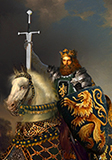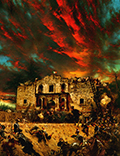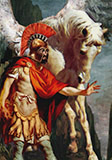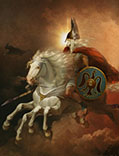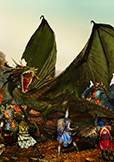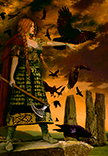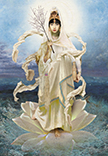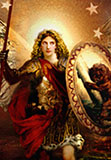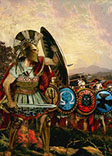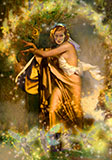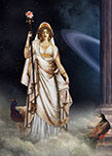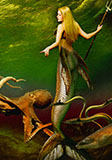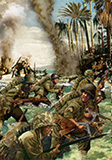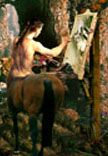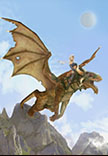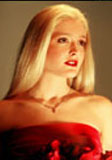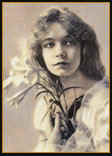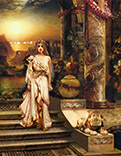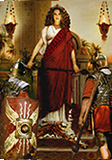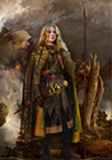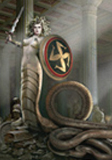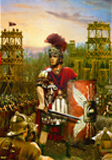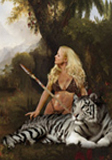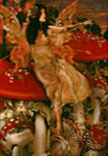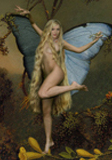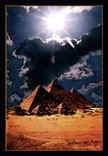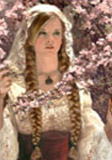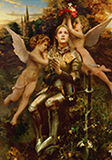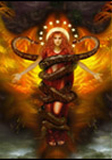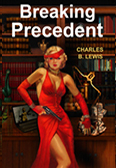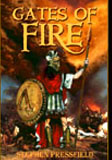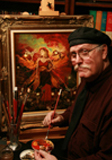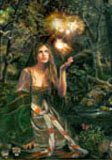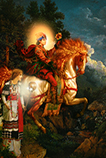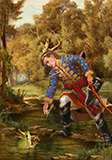Welcome
top our
Exhibit of 21st Century Angel Art and a brief introduction to
Angelology: Paintings
and Pictures of Angels, Angel names and Angel lore; Realistic paintings inspired by Classic
illustrators with
commentary by
American Illustrator & Biblical Scholar Howard
David Johnson, whose works have been published all over
the
world by distinguished learning institutions and publishers including
the
Universities of Oxford and Cambridge.
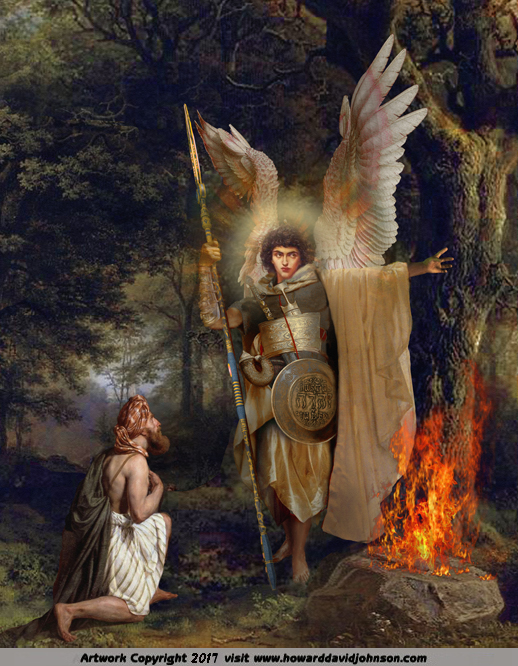
"The Angel of the LORD visits
Gideon"
|
Welcome to
our Gallery of Paintings, Drawings and Pictures of Angels~ Newly
Updated for 2024! Scroll down for new Angel Art...
Presents:
A Gallery of Angel Artwork Created for The Twenty-first
Century~
Artworks reflecting the beliefs and writings of the World's
Great Religions in mixed media including traditional oil
paints, acrylics, colored pencils and 2D & 3D digital media
following the style of the classic illustrators.
|
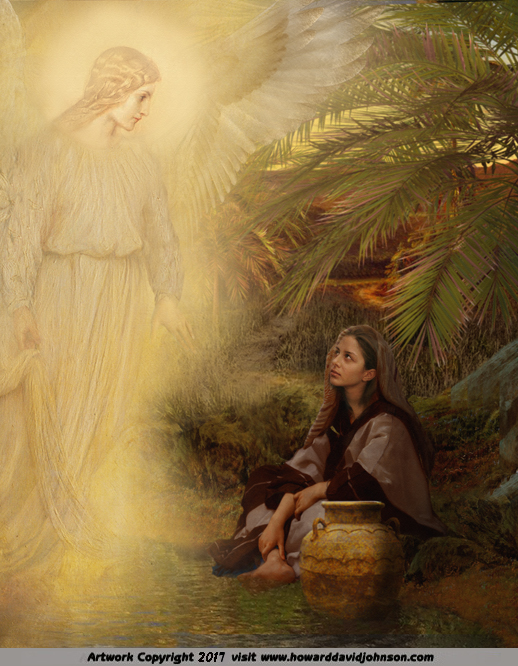
"The Angel visits Hagar in the
Wilderness"
|
Enter a world of
Beauty and Imagination...

|

"Uriel, Angel of
GOD " MMXXIV
|

"GOD's Holy
Messenger" MMXXIV
|

"Michael Warrior of GOD"
MMXXIV"
|






This gallery is devoted to the holy
angels who God has sent to minister to us and protect us every day....
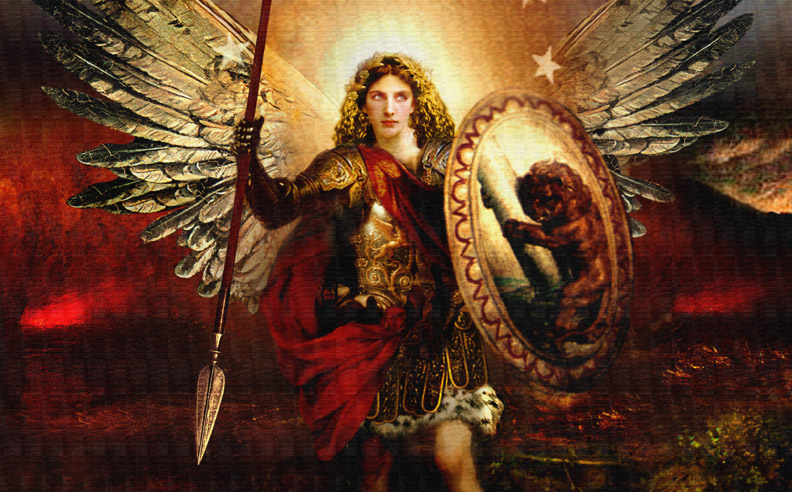
Angels: (from the
Latin Angelus meaning messenger) are a race of spiritual beings
intermediate between God and men; described in Hebrew,
Christian, and Islamic scriptures, as well as in the Kabala. They are
usually depicted with wings (but not always) and have no gender unless
granted physical form as males in a mission to the Earthly realm. They are also
a race of extraterrestrial beings that pre-existed mankind and were present at
the creation of the Earth and of Man. They are what could be called "The
Elder Race"
|
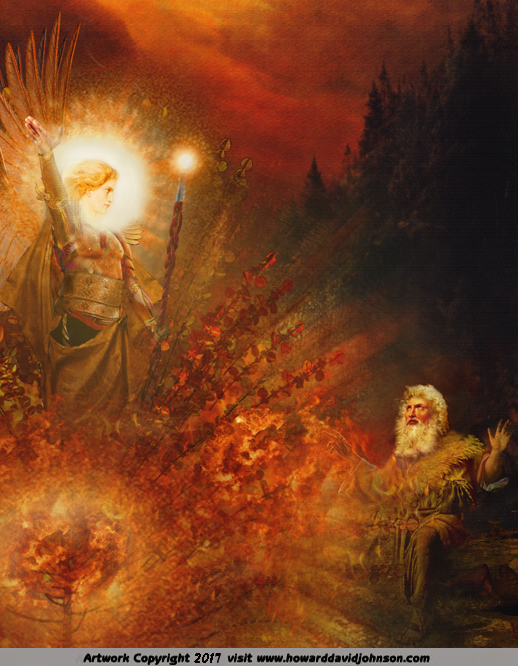
"Moses and the
Angel on Mt Sinai" MMVII
|
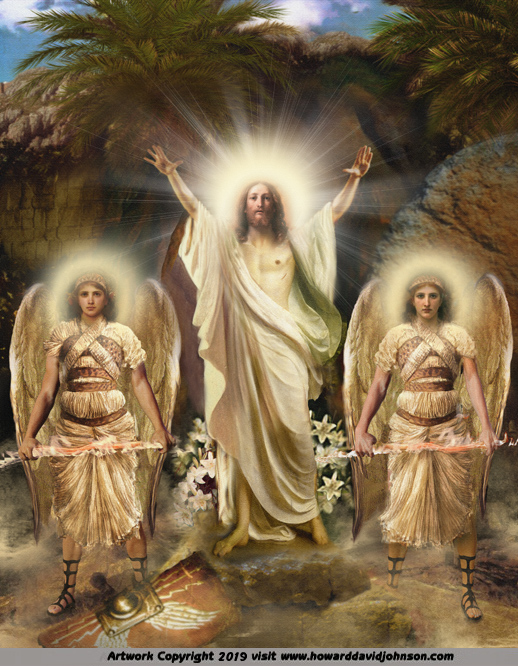
"The
Resurrection of the LORD Jesus Christ"
|
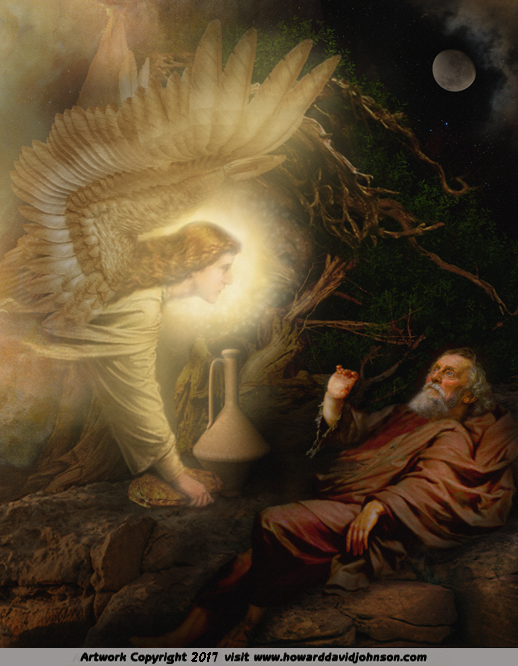
"Elijah and the
Angel" MMVII
|
They are celestial
attendants of almighty God. The most famous of them are Michael, Gabriel,
Raphael and Uriel.
The nature of angels is that they are servants of God and have no
free will, they were made of fire as men were made from clay and do
only that which God bids them.
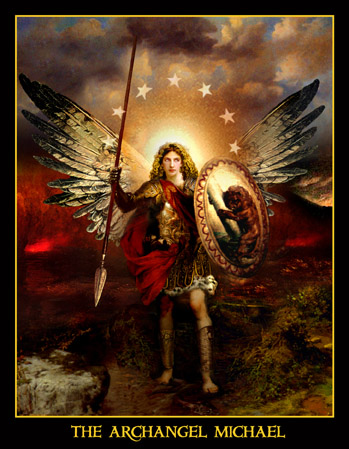
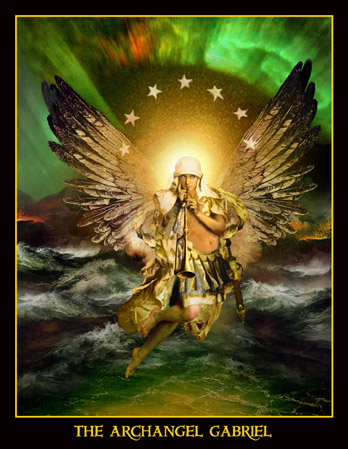
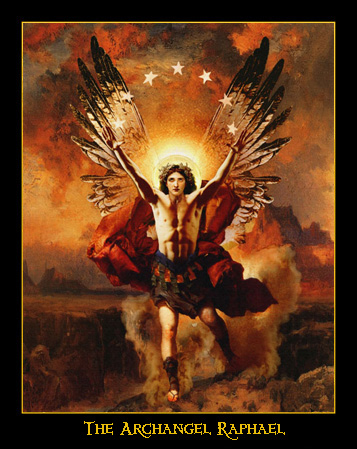
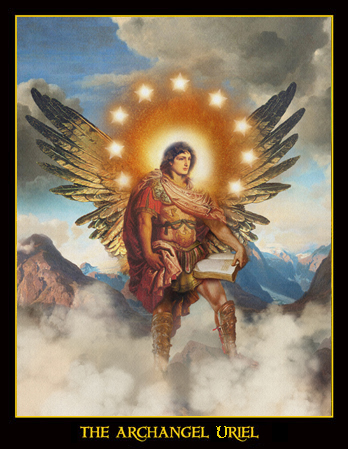
The Four Cardinal
Archangels~ "The Pillars of The EARTH"
In traditional angelology, angels constituted the lowest of
the nine celestial orders (seraphim, cherubim, thrones, dominations or
dominions, virtues, powers, principalities or princedoms, archangels,
and angels). They served as messengers
and saviors to mankind, but tradition tells us a third of them rebelled
against the most high led by Lucifer, the most beautiful of them all in
a war in heaven before the Earth was formed. They were judged and are
now called demons and are as malevolent and pernicious as the holy
angels are kind and beneficial...
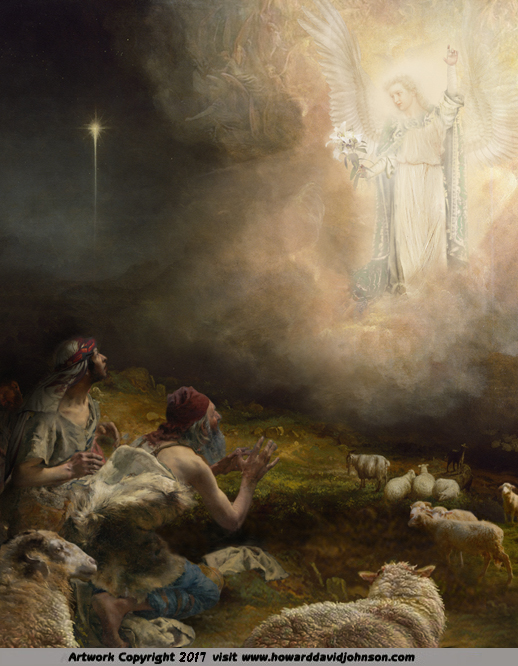
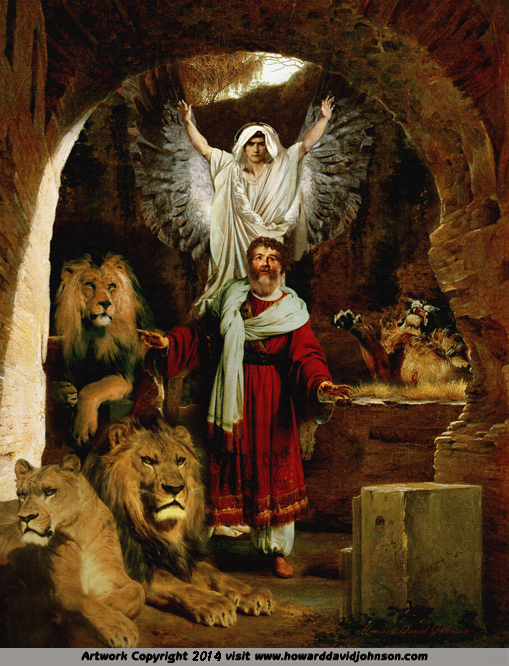
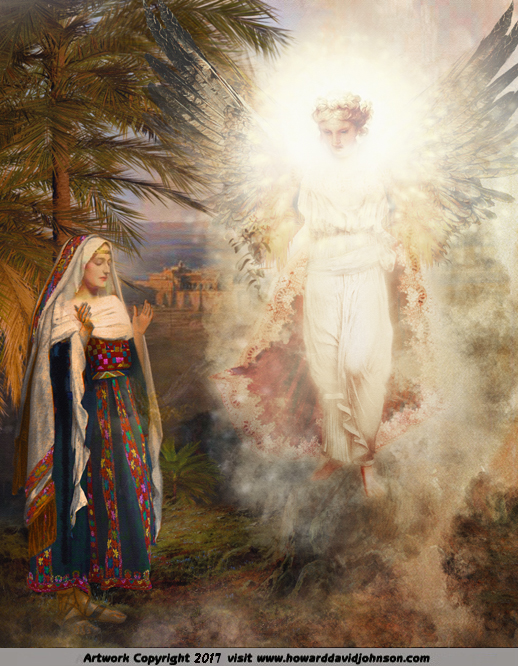
Angels endowed with divine
knowledge appear in the apocalyptic and rabbinic literature as the
teachers of men. This is the so-called "whisper of the angels". Michael
initiated Adam and Seth into the secrets of creation and taught Adam
agriculture. The angels Michael, Uriel, and Raziel initiated Enoch into
the mysteries of the world. The angels mediate between God and man and
carry the prayers up to the throne of God. Angels accompany the dead on
their departure from this
world.
|
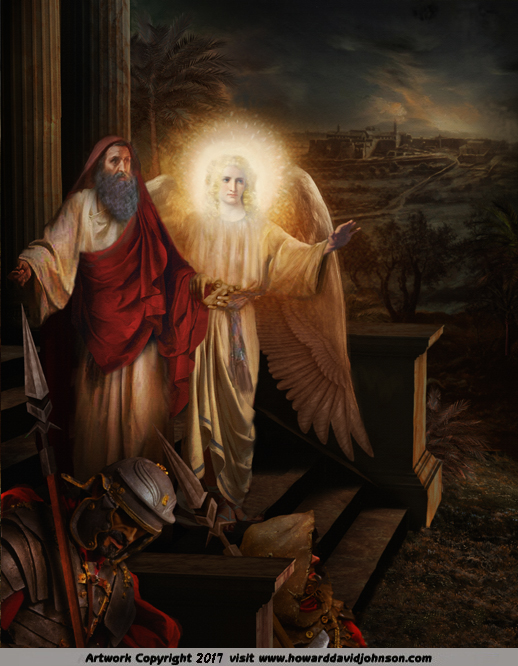
"St. Peter freed
from Prison"
|
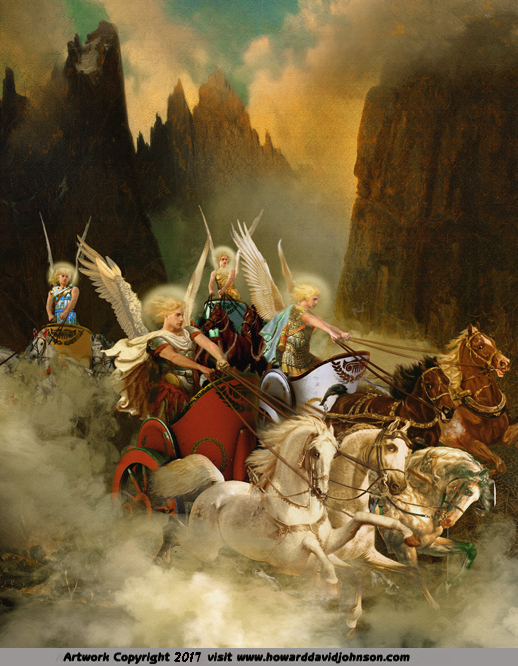
"Zechariah's Vision of the 4 Angel Chariots"
|
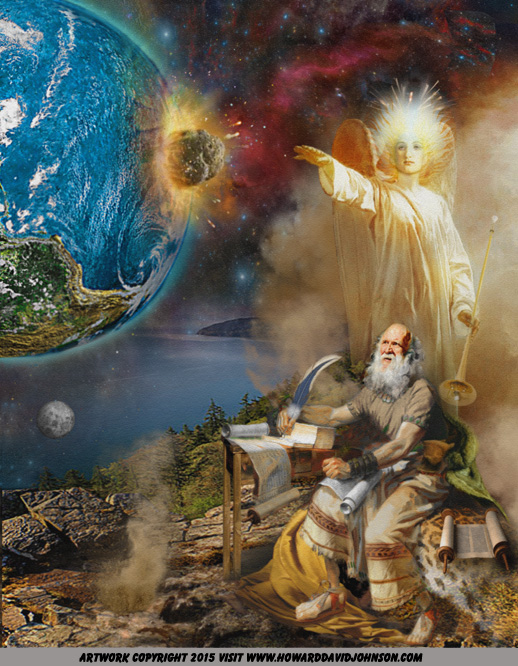
"The Angel with the Second
Trumpet"
|
|
How far this
Angelology was influenced by Babylonian and Persian mythology, and what
its relations are to Mandæan lore and to Egyptian-Hellenistic
Gnosticism, is still a matter of dispute but Persian mythology is
throughout and interwoven with Angelology (see Brandt, "Mandäische
Religion," pp. 194-198). Coptic Gnosticism, also, has Ariel as king of
the nether world, corresponding with Ur of the Mandæans.
|

"The Angel of Deliverance"
MMVIII
|
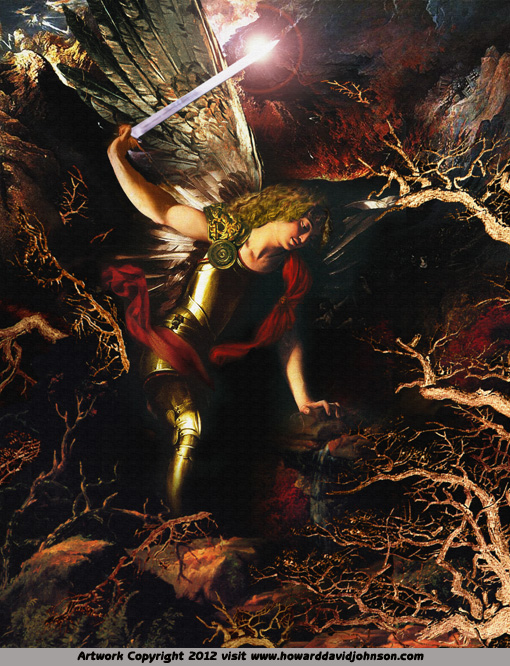
"Michael cutting through Fear"
MMVIII
|
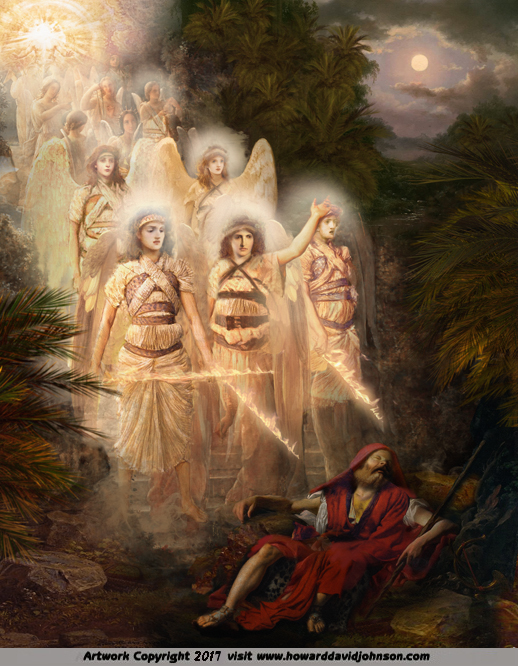
"Jacob's Ladder"
MMVII
|
|
Over thousands of years, mankind has described the functions
of angels in many ways. The role of angels is developed in greatest
detail in religions based on revelation - the disclosure or
communication of divine truth or divine will to human beings. These
monotheistic religions that share this view include Judaism,
Christianity, Islam, and Zoroastrianism.
|
|

|
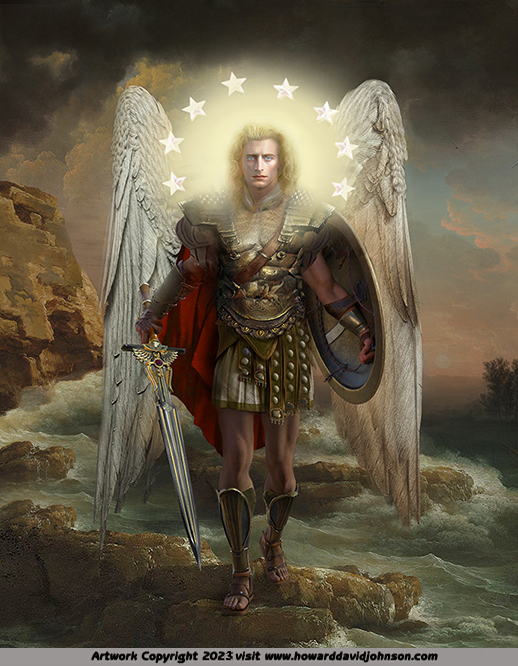
|
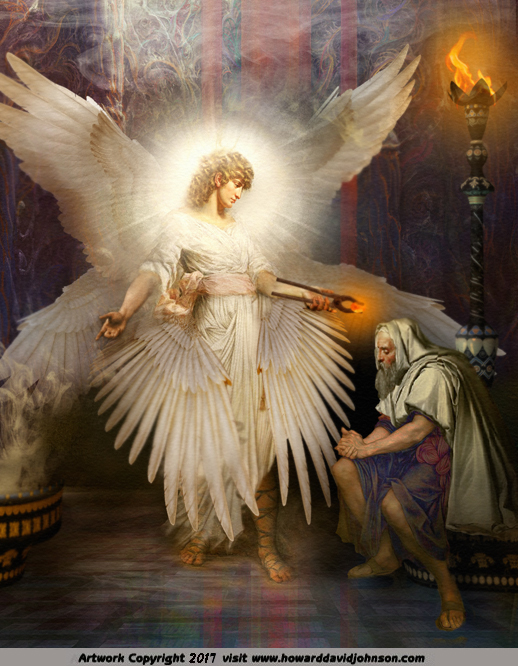
|
|
"The Angels at
the Tomb on Easter" MMXVII
|
"Archangel Zadkiel [God is my Righteousness]"
MMXXIII
|
"Isaiah and the
Seraphim" MMXVII
|
In
the Koran, Jewish and Gnostic angelologies seem to be intermingled. In
Mohammed's time the old Arabian goddesses—Al-Lat, Al-Uzza, and Manat
—were spoken of as angels and daughters of God (Koran, sura xxxvii.
v.150, liii. v.20). The chief of all the archangels is Gabriel
(Jibril); Michael comes next; Israfil (Sarafiel) sounds the trumpet of
the resurrection; and Azrael is the angel of death...
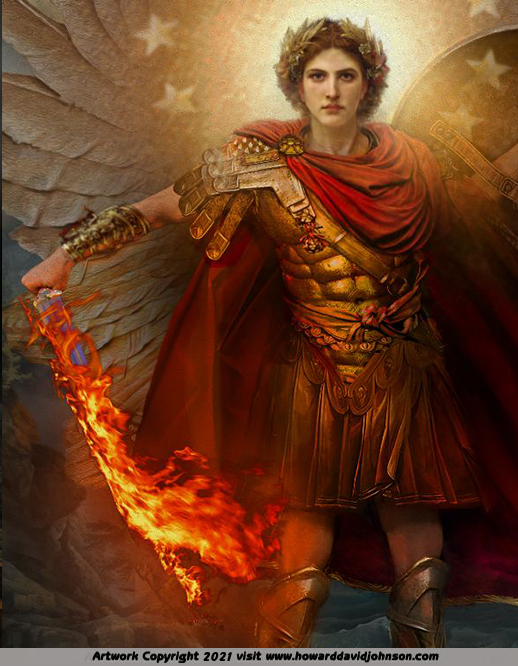
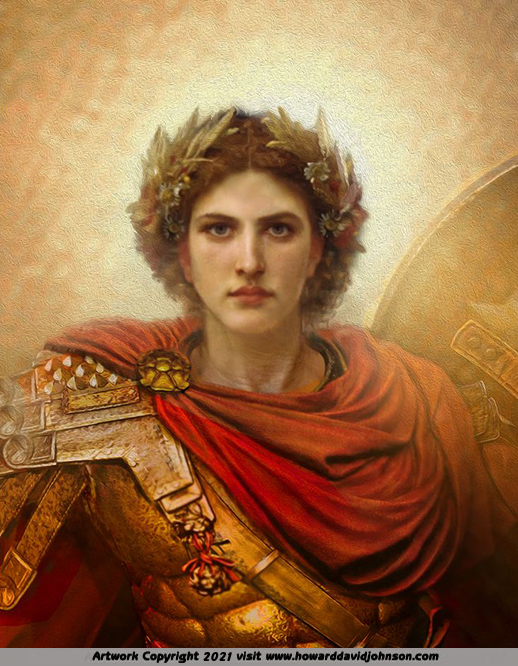
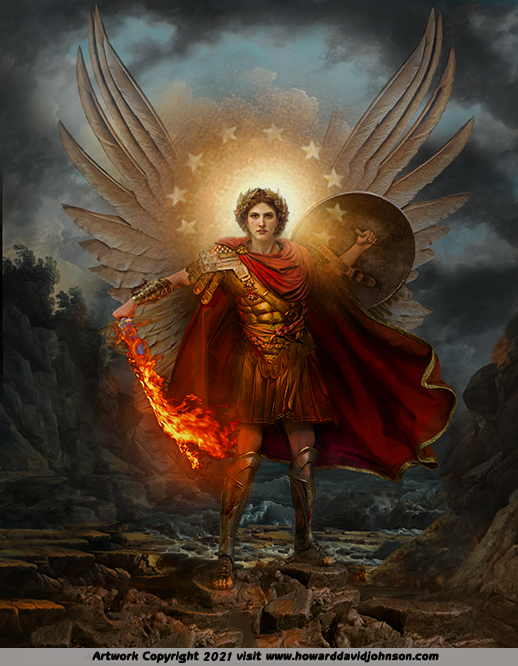
The chief of all the archangels ~ Gabriel (Jibril)
InIslam, instead of four, there are
eight angels that support the throne of God (sura xlix. v.17). Some
angels have two, some three, others four wings (sura xxxv. v.2). "They
celebrate the praise of their Lord and ask forgiveness for those that
are on earth" (sura xlii. v.2).






|
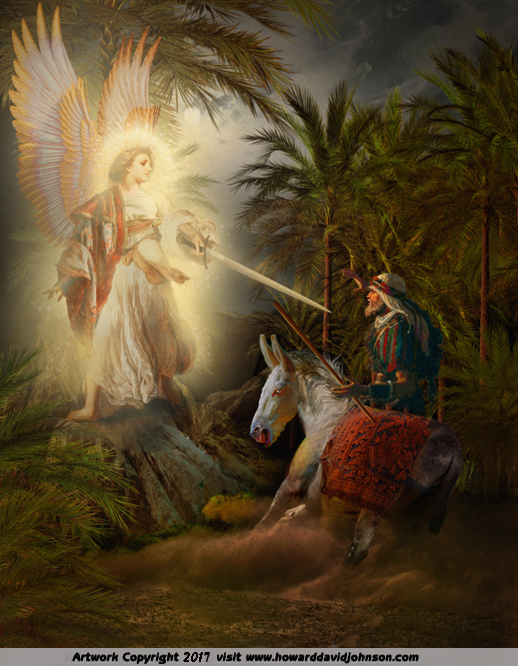
"The Angel of
the LORD & Balaam the false prophet" MMXVII
|
The Medieval Jewish
philosopher Maimonides taught that angels are creatures possessing form
without matter.
They are pure spirits differentiated from one another
not by any bodily distinctions but solely by spiritual form and
purpose, that the angels are only seen in the Bible as creatures of
fire and human form with wings as a feature of the prophetic vision.
Philo of Alexandria, a Hellenistic
Philosopher (20 BC-50 AD) was inclined to accept the existence of
angels as a fact far more than his allegorical system would lead one to
surmise.
|

"The Angels of
Forgiveness" MMX
|
He
was prompted to do so through the example of the Stoics; they are
"souls hovering in the air"; "some have descended into bodies; others
have not thought fit to approach any part of the earth; and these,
hallowed and surrounded by the ministrations of the Father, the Creator
employs as assistants and ministers for the care of the mortals."
|
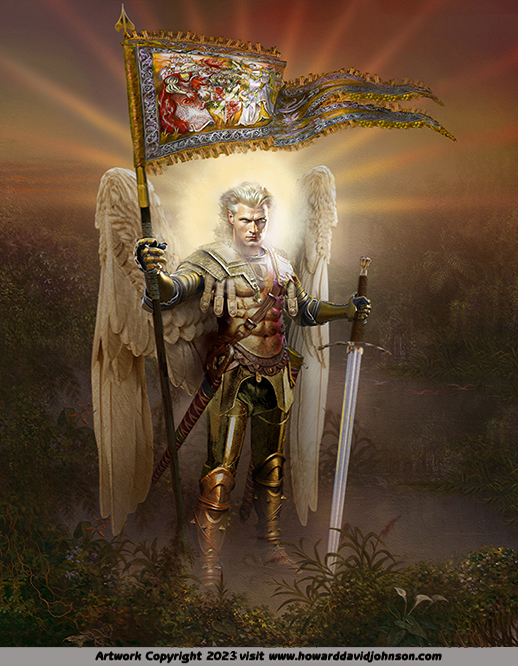
"And his banner over us is Love" MMXXIII
|

"Yofi-El-Divine Beauty [Angelic Prince of the Torah]" MMXXIII
|
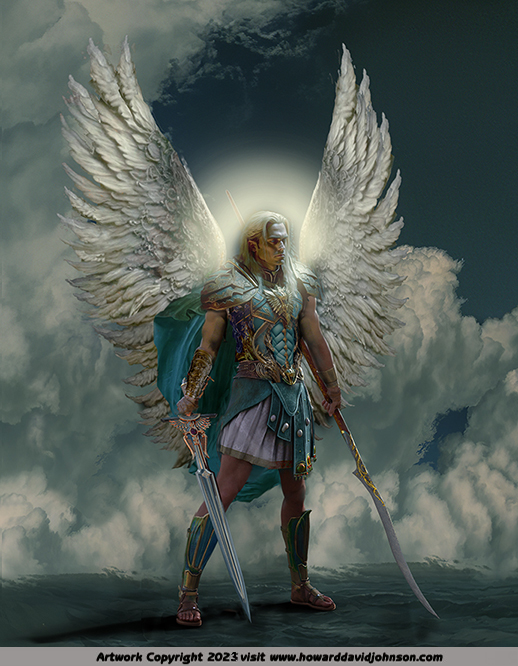
"Zahabriel- Angelic Guardian of the 1st Heaven" MMXXIII
|
They report the injunctions of the Father to His children, and
the necessities of the children to the Father. And, with reference to
this, Holy Scripture represents them as 'ascending and descending.' . .
. Not God, but we mortals are in need of a mediator and intercessor"
(Philo, "On Dreams," i. v.22). "Souls, demons, and angels are things
differing in name, but identical in reality.
Yet, as men speak of God and of evil demons and of good and evil souls,
so they speak of angels, calling them
ambassadors of man to God and of God to man; and they are holy because
of this blameless and honorable office. Others, on the contrary, are
profane and unworthy, as is seen in Ps. lxxviii. 49" (Philo, "On
Giants," pp. 3-4).
|
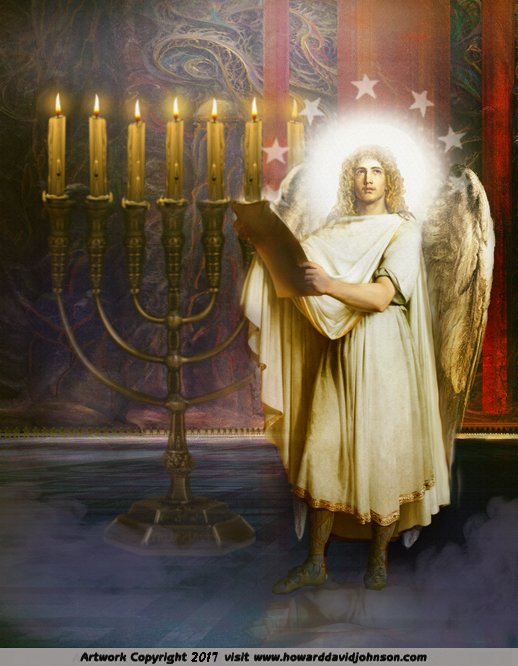
"The Angel who stands in the
presence of God" MMXVII
|
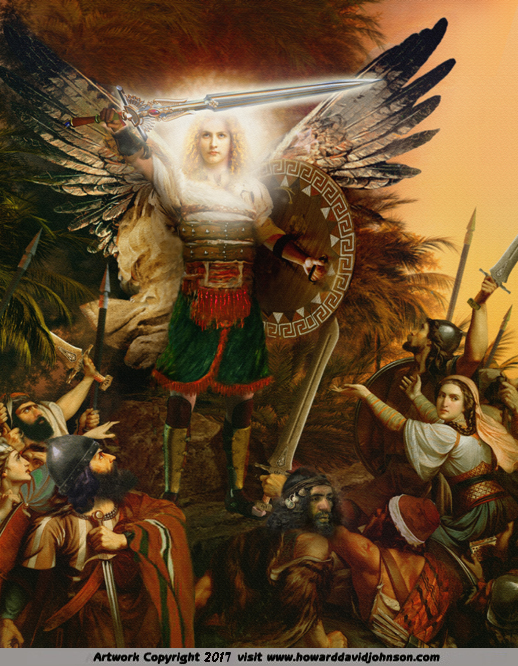
"The Captain of the LORD's Host
appears to Joshua" MMXVII
|
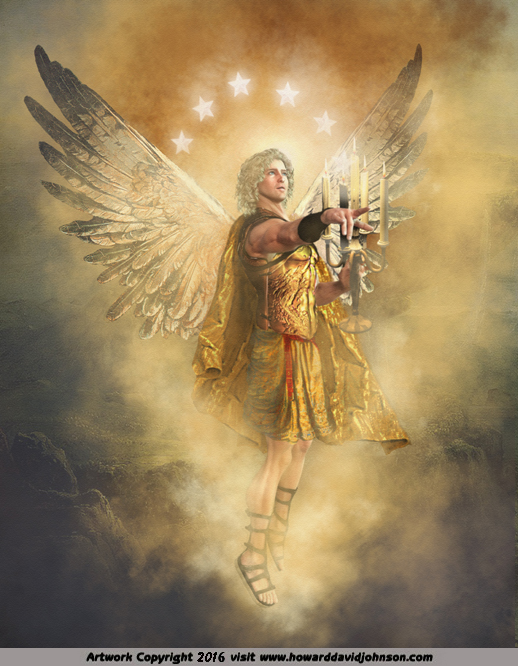
"I am your fellow servant ~
Worship only God" MMXVII
|
|
In religions based on revelation, God and humans are usually
distant from each other. Angels serve to bridge the gap. Angels praise
and worship God, reveal the divine word and carry out God's will. They
may also help people attain deliverance, comfort or receive special
favors. Furthermore, in acting for God, angels may influence human
affairs through such acts as rewarding faithful believers, punishing
those who do evil, and helping those in need. An
angel set over the beasts is mentioned in Hermas' "Visions," iv. V.2;
his name is Thegri. Angels
tend to play a less important role in religions that worship many gods.
These gods themselves may carry out angelic functions, often taking on
a human appearance.
|

"The Angel comforts Christ at
Gethsemane " MMXVII
|
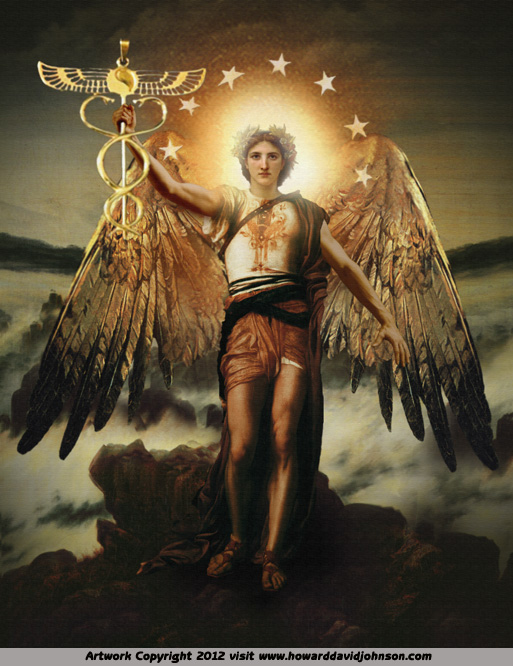
"Raphael with Caduceus Staff"
MMV
|
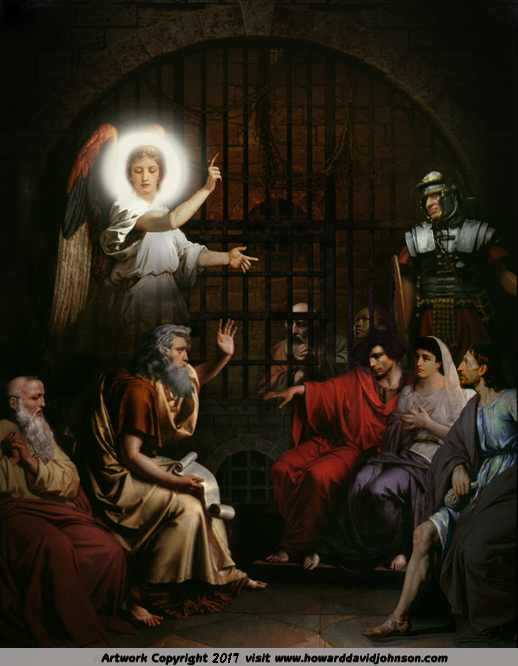
"St Paul
Preaching in Prison" MMXVII
|
In religions based on the belief
that everything is god and that the universe and mankind share one
essence, angels are far less important. They are not needed to bridge a
gap between divinity and mortals. However, even in these religions
angel-like spiritual beings may help people
relate to divinity. It is in the Book of Daniel that a
systematic classification of angels is first presented. In Joshua
(5:13-15)
reference is made to "the captain of the Lord's host".
|
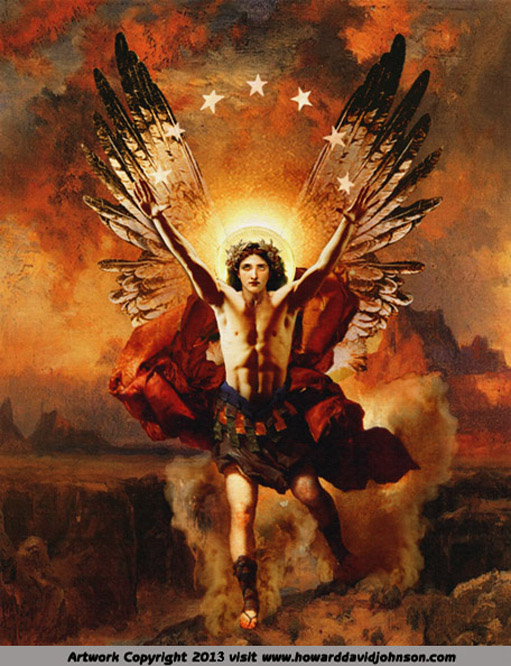
"The Angel Raphael" MMVIII
|
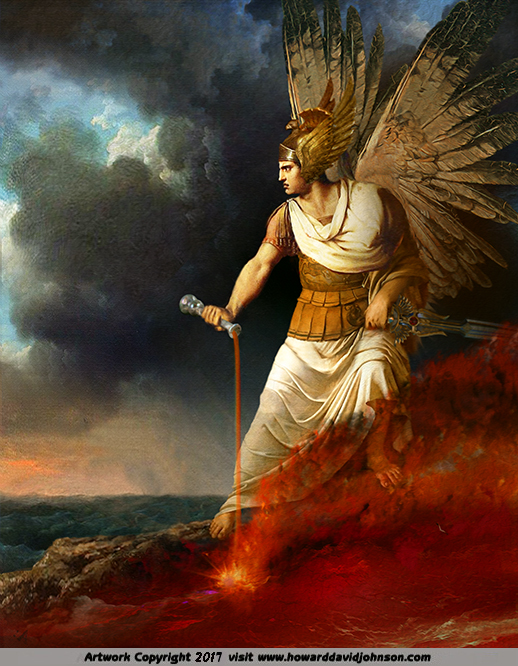
"The 2nd angel poured out his
vial upon the Sea"
|
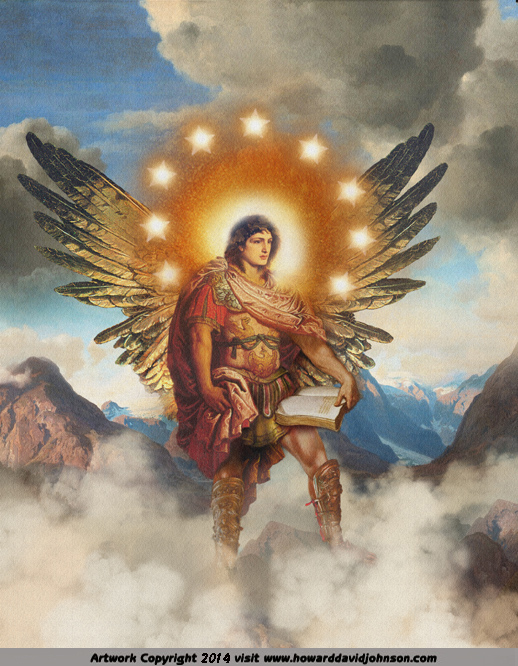
"The Archangel Uriel"
|
REVELATION 16 ~ The
Seven
Angels with Seven Vials
3 And the second
angel poured out his vial upon the sea; and it became as the blood of a
dead man: and every living soul died in the sea.
4 And the third angel poured out his vial upon the rivers and fountains
of waters; and they became blood.
5 And I heard the angel of the waters say, Thou art righteous, O Lord,
which art, and
wast, and shalt be, because thou hast judged thus.
6 For they have shed the blood of saints and prophets, and thou hast
given them blood to drink; for they are worthy.






Jewish
tradition lays down A Heavenly Hierarchy,
The process begun in The book of Daniel, and continued
through the entirety of apocalyptic literature, finally revealed a
heavenly hierarchy of stupendous proportions. In "The
Celestial Hierarchy" written by Pseudo-Dionysius the notion is set
forth that archangels and angels were the lowest of the Angelic orders
and were the only angels directly involved in the worldly affairs of
mankind.
|
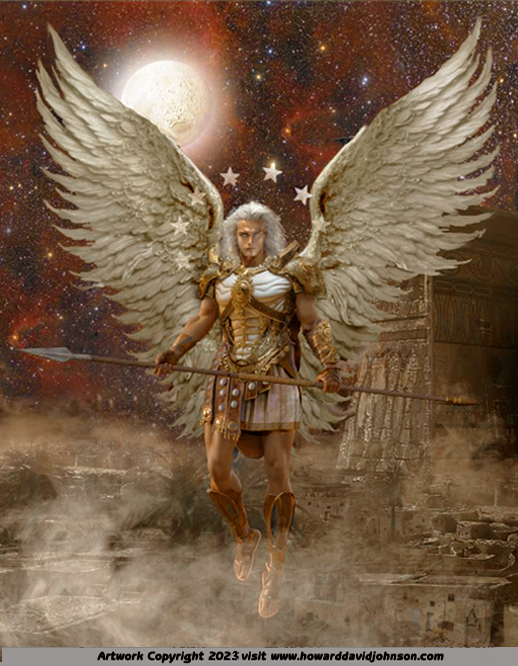
"Azrael, The Angel of Death over Egypt"
MMXXIII
|

"Phanuel the Angel of Judgement" MMXXIII
|

"Phadihel An angelic
guard of the West Wind gate"
MMXXIII
|
According to The Book of Enoch there are SEVEN Archangels:
"holy ones who watch"):
(1) Uriel ["God is Light"; set over the world's
luminaries
and over Sheol [compare Enoch, xxi. v.5, xxvii. 2, xxxiii. v.3, 4]; (2)
Raphael, set over the spirits of men [compare Enoch, x. 4, where he is
told to bind Azazel and to heal the earth with Tobit—iii. v.17]; (3)
Raguel [Ra'uel, "the terrifier"], who chastiseth the world of the
luminaries; (4) Michael, set over the best part of mankind, over the
people of Israel; (5) Sariel [Æth., Sarakiel, Suriel, "God turneth"?],
set over the spirits who seduce the spirits to sin; (6) Gabriel, set
over paradise, the serpents [seraphim?], and the cherubim; (7)
Jerahmeel ["God is merciful"], whom God set over the resurrection.
|
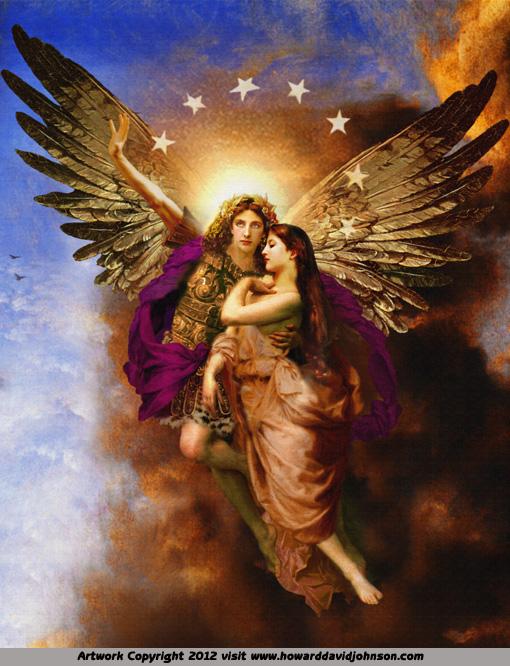
"Escorting a Soul to Heaven" MMVII
|
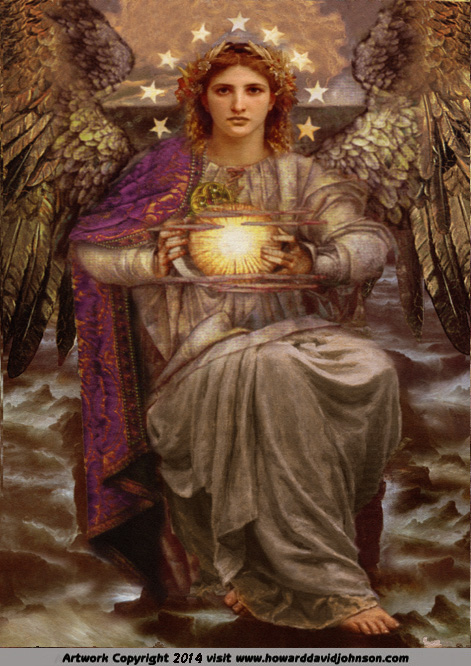
"The ANGEL of Prophecy" MMVIII
|
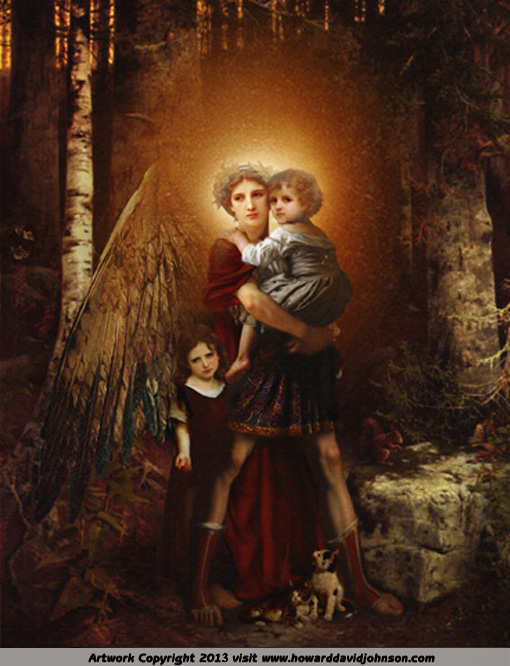
"The Guardian Angel" MMVII
|
Angels
accompany the dead on their departure from this world. Accompanying
angels are not permanent, but temporary, companions, they carry out
missions but can be constantly re-dispatched by the least of us through
faithful prayer as answered by the almighty. No single angel can carry
out two messages, nor can two angels fulfill only one message. Of the
three angels that came to Abraham, Michael, the guardian angel of
Israel, brought the tidings of Isaac's birth; Gabriel, the angel of
heavenly vengeance and of fire, had to overthrow Sodom; and Raphael
rescued Lot" (Gen. xviii. v.2). Michael to the right, Uriel to the
left, Gabriel in front, and Raphael in the rear of the throne. The Book
of Jubilees, a version of the Pentateuch speaks of the Creation of
Angels: "The angels of the face and of glorification, the
angels of the elements of fire, wind, and darkness, of hail and hoar
frost, thunder and lightning, of cold and heat, of winter and spring,
summer and fall, of the abyss and night, of light and morning, were
created on the first day. "Since Medieval
times
Christian theology has taught that
Angels
are organized into several orders, or Angelic Choirs.
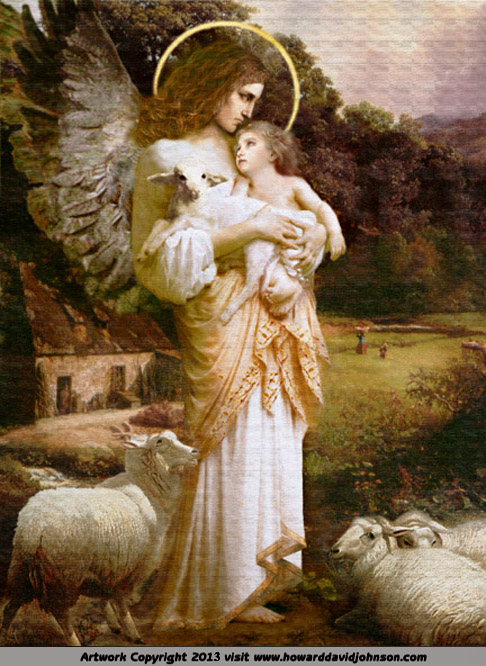
"The Ministering Angel of
Comfort" MMVIII
|
\
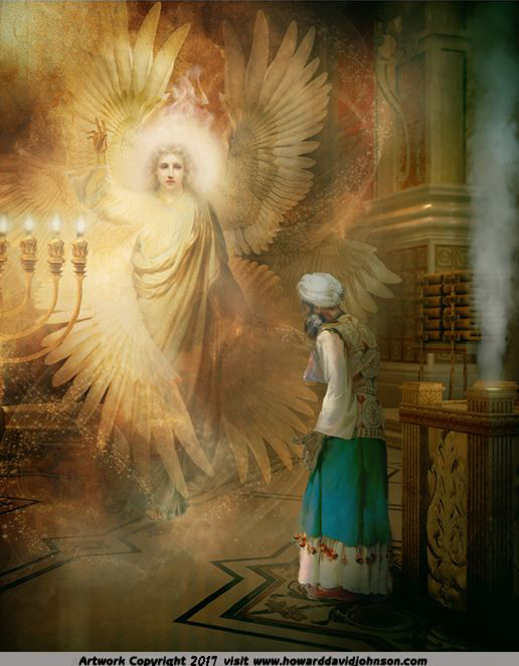
"Zechariah and
the Seraphim in the Temple" MMXVII
|
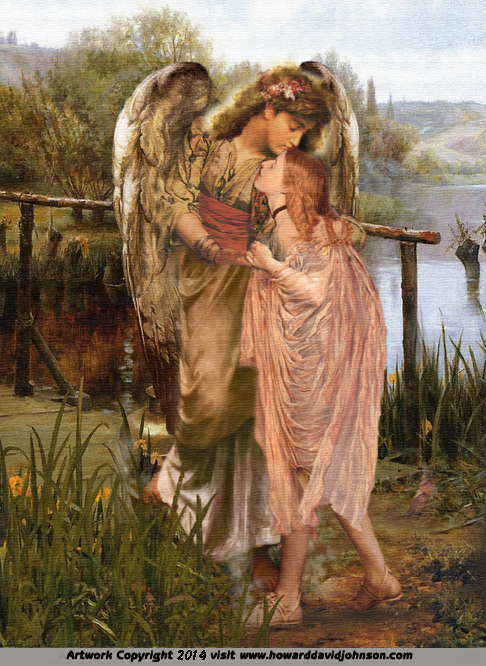
"Kissed by an Angel"
|
In the Book of Tobit the name
of a third angel appears—namely, Raphael ("God healeth," Tobit, iii.
v.17)—called thus after his mission. "God hath sent me," he says, "to
heal thee and Sarah, thy daughter-in-law. I am Raphael, one of the
seven holy angels, which present the prayers of the saints, and which
go in and out before the glory of the Holy One" (Tobit, xii. v.14-15). The angels that execute God's judgment are called "the
angels of punishment" Each angel has a tablet on his heart on which his
name, combined with the name of God (EL).
Four Angels of the Throne: On the other hand, Michael,
Gabriel, Uriel, and Fanuel (Penuel) are introduced as "the four angels
of the face of the Lord." After the watchers ("those that sleep not")
have been described (ibid. xxxix. v.12, 13) as chanting the "Holy,
holy, holy!" and mutually responding, "Blessed be the name of the
Lord!" the following passage occurs (ibid. xl. 2):
"I saw on the four sides of the Lord of spirits four
presences [faces] different from those that sleep not, and I heard the
voice of those four presences as they gave glory before the Lord of
glory: The first [as the angel of peace explained it afterward],
Michael "who is like God?", merciful and long-suffering, blesses the
Lord of spirits for ever and ever; the second, Raphael, set over the
diseases of the children of men, blesses the Elect One [the Messiah]
and the elect ones who cleave to the Lord of spirits [the pious ones];
the third, Gabriel ["the mighty one of God"], set over all the powers,
intercedes in behalf of the inhabitants of the earth [see Enoch, x.
9-10, 12-14]; and the fourth, Fanuel [Penuel "turning to God"], set
over repentance and hope of eternal life, prevents the Satans from
accusing men."
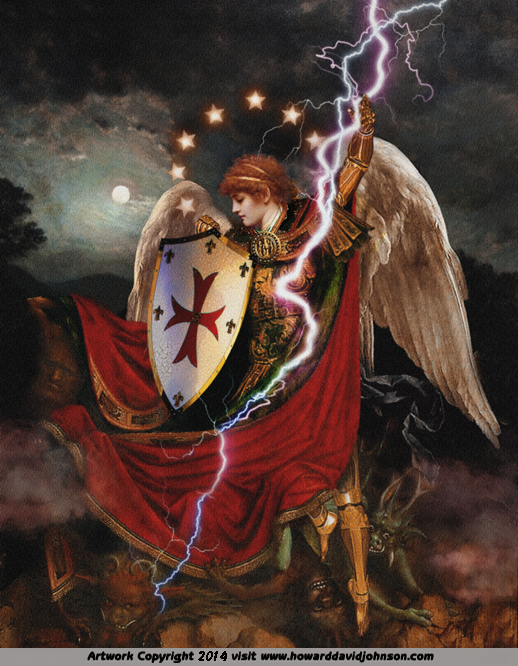
"The Seraphim Barachiel The
Lightning of God"
|
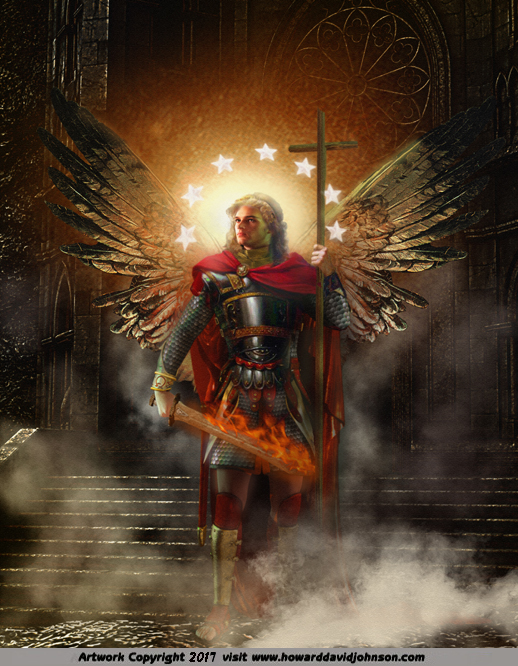
"The Angel Guardian of the
Church at Ephesus"
|

"The Angel of the LORD answers
Daniel"
|
Then again mention is made
of seven classes of angels (Enoch, lxi. v.10 et seq.): (1) the cherubim,(2) seraphim, (3) ofanim, (4) all
the angels of power, (5) principalities, (6) the Elect One (Messiah),
and (7) the (elementary) powers of the earth and the water. They are
endowed with seven angelic virtues—one more than is ascribed to the
Messiah (Enoch. lxi.; after Isaiah. xi. v.2): "In the spirit of faith,
of wisdom, of patience, of mercy, of judgment, of peace, and of
goodness they glorify, saying: 'Blessed is He, and may the name of the
Lord of spirits be blessed for ever and ever.'"
A parallel to this is offered by the
Testaments of the Patriarchs in Test. Levi, iii., where this
description of the seven heavens is given:
"In the highest of which dwelleth the great Glory in the Holy
of Holies, and beneath it are the angels of the presence of the Lord,
who minister and make propitiation to the Lord for all the ignorance of
the righteous. . . And in the heaven below this are the angels
who bear the answers to the angels of the presence of the Lord, and in
the heaven next to this are thrones and dominions in which hymns are
offered to God; in the third heaven there are hosts of the armies
ordained for the day of judgment, to work vengeance on the spirits of
deceit and of Belial; the second has fire, snow, and ice ready, all the
spirits of retribution for the day of judgment; and the lowest is
gloomy because it is near the iniquities of men."






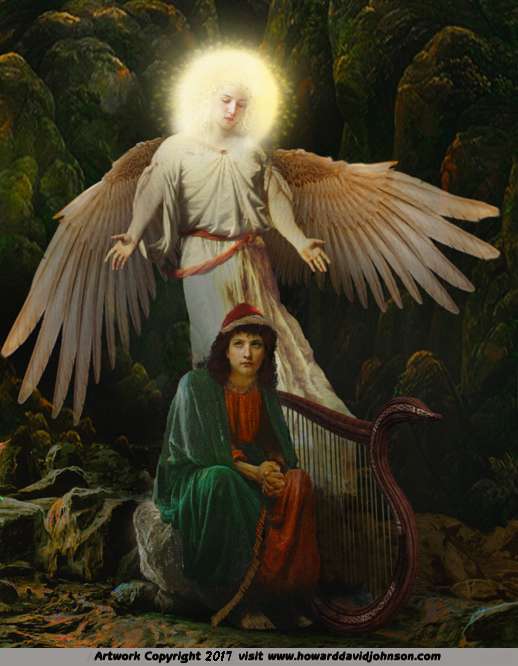
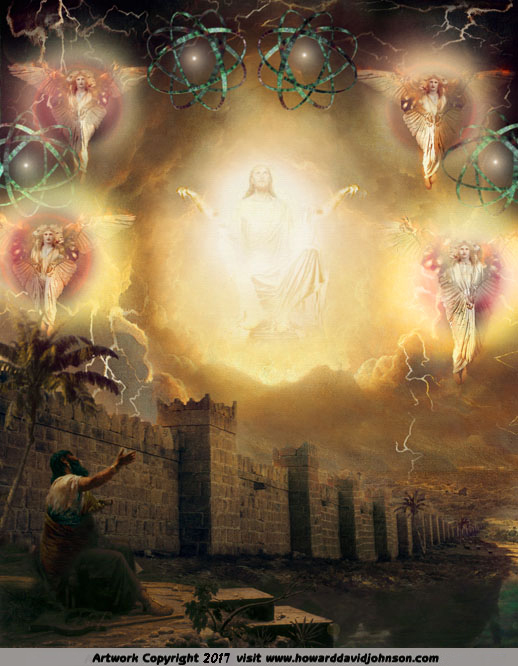
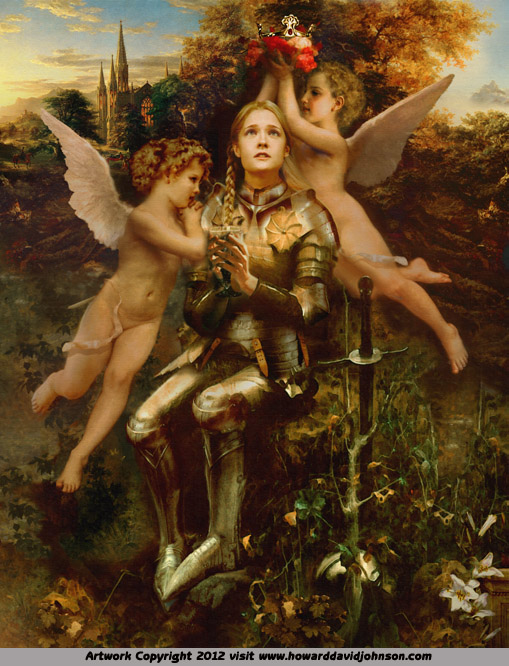
"Young King David in
the
Caves of Adullum" MMXVII [left], "Ezekiel's
Vision" MMV [center] and "Joan of Arc" MMV [right]
Cherubs and Cherubim
With this
Heavenly hierarchy firmly in mind,
a look at the visual portrayals of Angels in the
Western Art tradition seems appropriate, particularly Cherubs
and Cherubim; above are two very different interpretations : "Joan
of Arc" MMVI (left) has the popular and time honored but incorrect
interpretation of "Cherubs" or more aptly "Putti" and "Ezekiel's
Vision" MMX (right), with more accurate six-winged Cherubim Angels
with three faces each from descriptions in the visionary Book of
Ezekiel chapter one. Classical (or Greco-Roman) tradition has
influenced Christian art from it's earliest origins. Since the
conversion of Constantine in 313 A.D. The earliest Christian
catacombs and tomb art incorporated the popular Greco-Roman Putti (or
little Cupidic figures). The Putto were revived with passion in the
works of Donatello and Raphael and became commonplace in the
renaissance before they became one of the most dominant interpretations
of Angels in painting and sculpture. The misuse of the term Cherubs for
the Putti and their use in art as symbols of innocence has become so
commonplace and time honored that it is now considered correct.
Commonplace and correct are not always the same. Most people don't even
know about the authentic Cherubim, who are among the highest ranked and
holiest of God's Angels or realize they have been replaced with
mischievous little demons from Pagan religion in much of our Western
Art tradition.

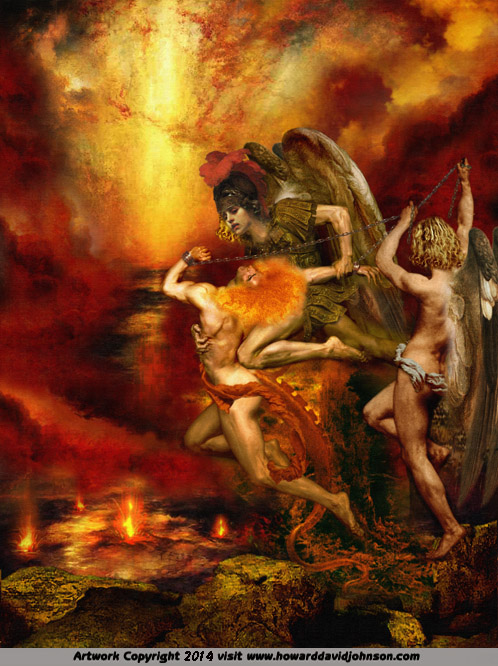
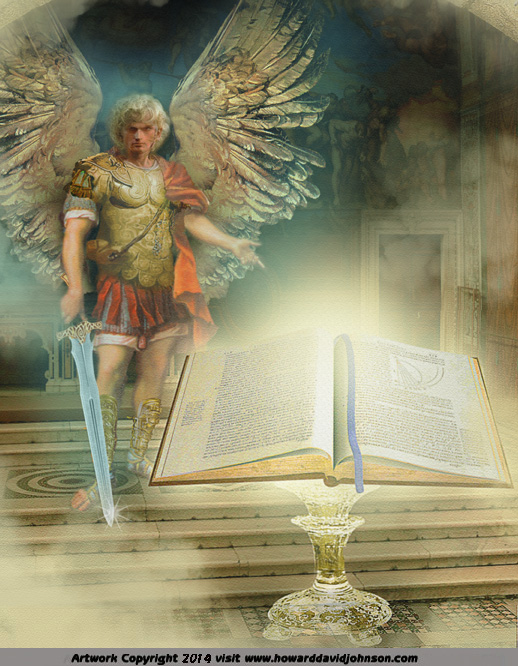
" Zadkiel the Standard
Bearer
of the LORD" MMXX [left], "Into the Lake of Fire" [center] and
MMXIV "The Book of LIFE" MMXIV [right]
ANGELS and DEMONS
The Book of Revelation Ch. 20:
"The Dragon that old serpent, that is the Devil, cast in the Lake of
Fire where he will be tormented for ever and ever." Satan is
one of the sons of God (Job, i. 6, ii. 1). This makes the problem of
evil all the more difficult.
|
The Biblical story of the sons of
God marrying the daughters of men (Gen. vi. 1-4), implying the
possibility of angels lusting and sinning, suggested the idea of a
fall, not only of man, but of pure heavenly beings as well. Taken
together with the (Babylonian?) legends of Lucifer (Isaiah. xiv. 12),
it seemed to take for granted the existence of evil spirits working
antagonistically to God through the evil practices of witchcraft,
astrology, and the like. Fallen angels became progenitors of hosts of
evil spirits and seducers of men to crime and vice.
Still, they were finally
subjugated by the power of heaven, and punished by the archangels
Raphael and Gabriel, and consequently a knowledge of their names would
enable one to control them. The names of angels formed a favorite study
of the Essenes in view of the magical cures effected by means of these
names; for upon the accurate knowledge of the name and sphere of each
angel. In the Testament of Solomon pp. 1-45 (an apocryphal
book).
In the Book of ENOCH, the
seventh from ADAM, the Watchers who had been sent to Earth to watch and
pray for mankind, instead taught them abortion, weapon making and war,
face painting and magic and fornicated with them. They came and begged
ENOCH to pray for them, that GOD would have mercy on them. Their names
as well as those of the faithful are listed therein...
|

"Enoch and the
Watchers" MMXIV
|
|
King Solomon's experiences
confronting demons are related, of each of whom he asks his name as
well as the name of the angel that can overpower him. Asmodeus answers
that he is frustrated by Raphael, the archangel; another demon answers
Paltiel is his most feared antagonist; a third, Uriel, etc. In Mark's
Gospel 5:9; Christ does this as well. (Jesus) "...asked him, What is
thy name? And he answered, saying, My name is Legion: for we are many."
Then he cast them all out. Jesus' disciples came to
him about their failures in Matthew 17:21 and he told them "...an evil spirit of this kind is only
driven out by prayer and fasting". In the Book of Acts 19 v.13-18 The
Seven sons of Sceva were professional exorcists and attempted to rebuke
evil spirits the name of the Lord Jesus, saying, "I adjure you by Jesus
whom Paul preaches." And the evil spirit answered and said to them, "I
recognize Jesus, and I know about Paul, but who are you?" and the
spirit overpowered him. It was like signing a check with someone else's
name when you were not granted power of attorney. Becoming a Christian
gives us that power of attorney to use his name in these matters
according to the Bible.
|
The PORTAL Guardians of Enoch's Vision
The gateways
between the physical and
spiritual worlds...
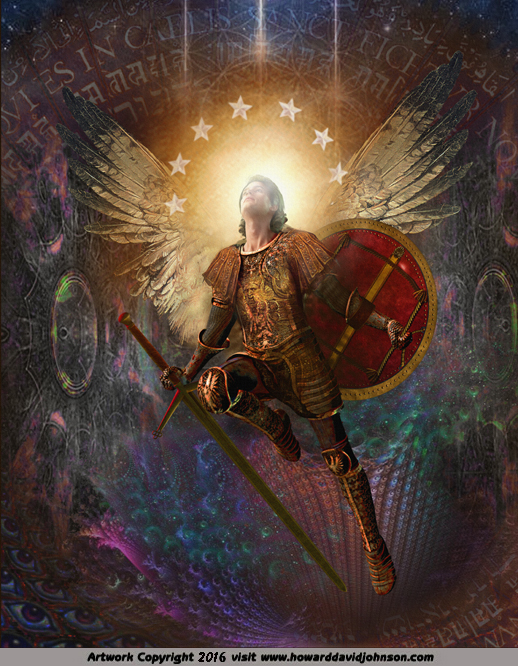
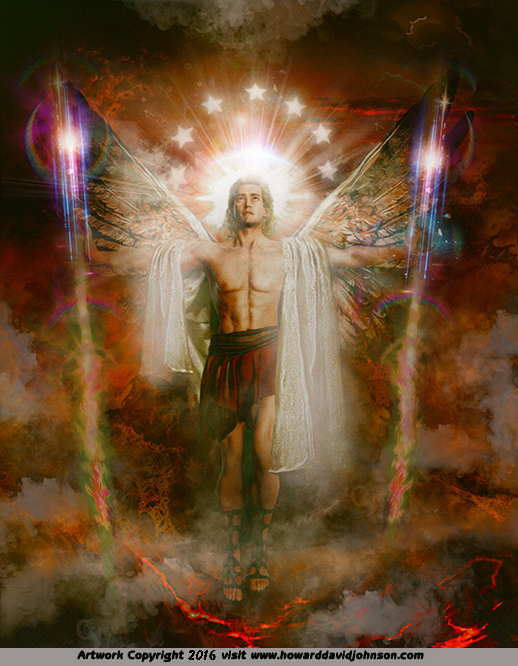
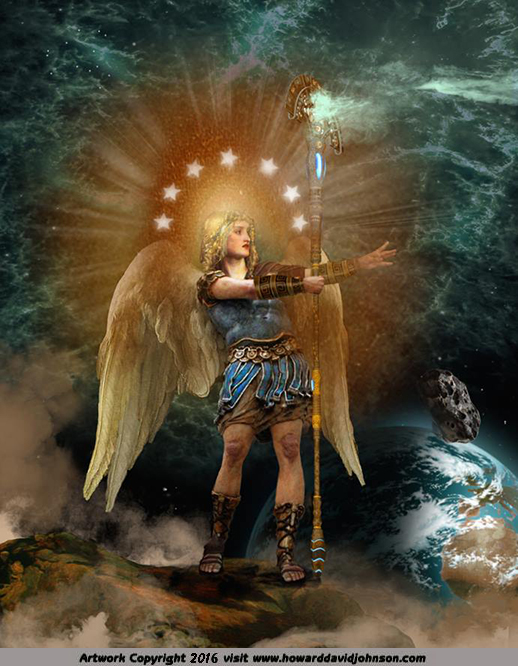
More of Enoch's
Visions ~ "Guardian of the Northern Portal" MMXVI [left], ["Guardian of the Southern Portal" MMXVI
[center] and "Guardian of the Eastern Portal" MMXVI [right]
The Guardians
of the four portal gates from The Book of Enoch" Angels from the second
sphere called "Dominions" (Eph. 1:21; Col. 1:16) (lat.
dominatio, plural dominationes, also translated from the Greek term
kyriotētes, pl. of kyriotēs, as "Lordships") or "Dominations" are
presented as the hierarchy of celestial beings "Lordships" in some
English translations of the De Coelesti
Hierarchia. The Dominions regulate the duties of lower angels. It is
only with extreme rarity that the angelic lords make themselves
physically known to humans.
The Dominions are believed to look like divinely beautiful humans with
a pair of feathered wings, much like the common representation of
angels, but they may be distinguished from other groups by wielding
orbs of light fastened to the heads of their scepters or on the pommel
of their
swords.
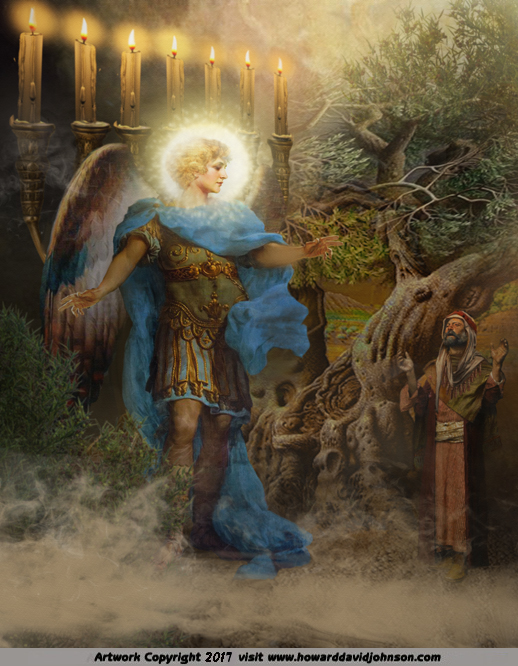
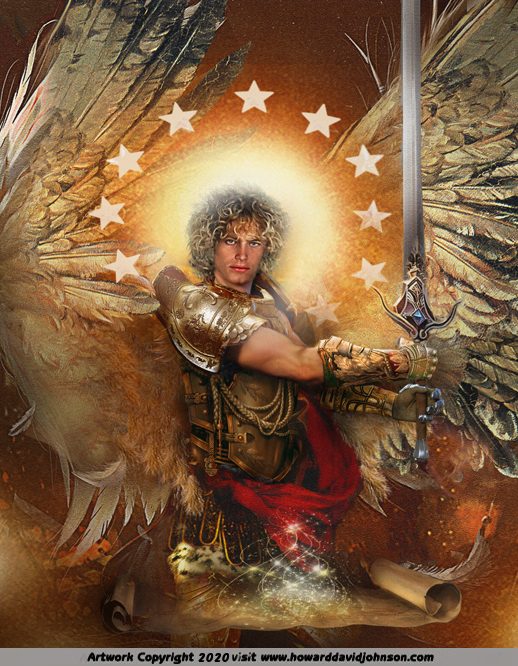
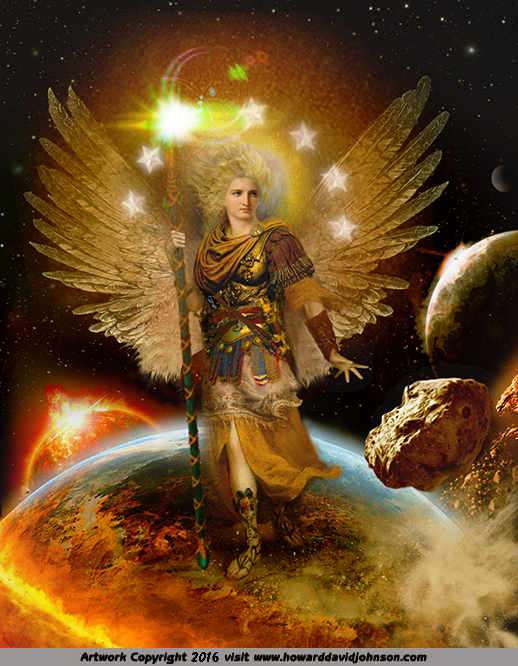
The Angel-Princes
of the Earth
There
is, however, a special angel-prince set over the world, Sar
ha-'olam (Yeb. 16b, Sanh. 94a). He composed the verses, Ps. xxxvii. 25,
civ. 31, and, partly,
Isa. xxiv. 16. He has been identified, whether correctly or
incorrectly, with Metatron. According to the Testament of Job (lii.),
this vice-regent "sitteth upon the great chariot" His "name is like the
name of his Master"
(Sanh. 38b, according to Ex. xxiii. 21), known under the name of
"Metatron"; frequently explained as "Metator," "Metathronos," and
"Metatyranos." Already in Dan. x. 20-21, the idea prevails that each
nation has a heavenly guardian angel or prince. In Enoch, lxxxix. 59,
the seventy shepherds are the guardian angels of the seventy nations
over whom Michael, as Israel's angel-prince, is set as ruler. With
these seventy-one angel-princes of the world God sits in council when
holding judgment over the world (Hebrew Enoch; Jellinek, "B. H." v.
181); each pleading the cause of his nation before God. But The
Archangel Michael, the angel-prince of Jerusalem (Zion, Targ. Ps.
cxxxvii. 7-8), is set over all the seventy angels.
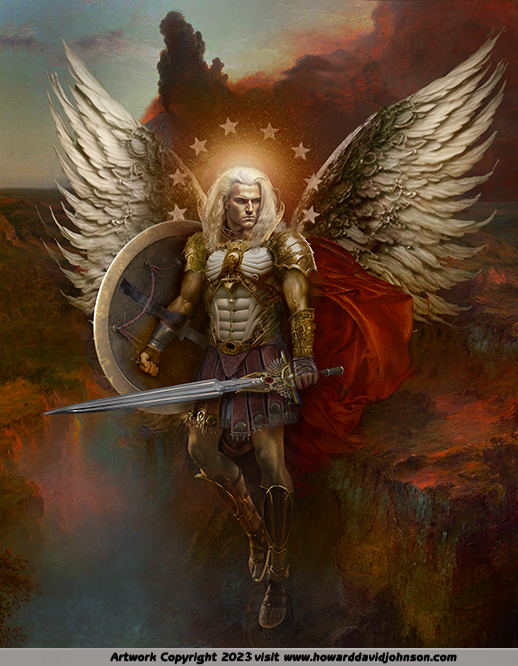
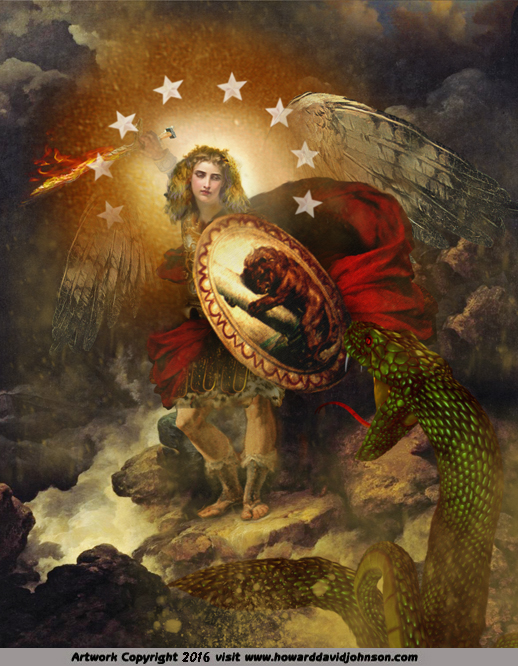
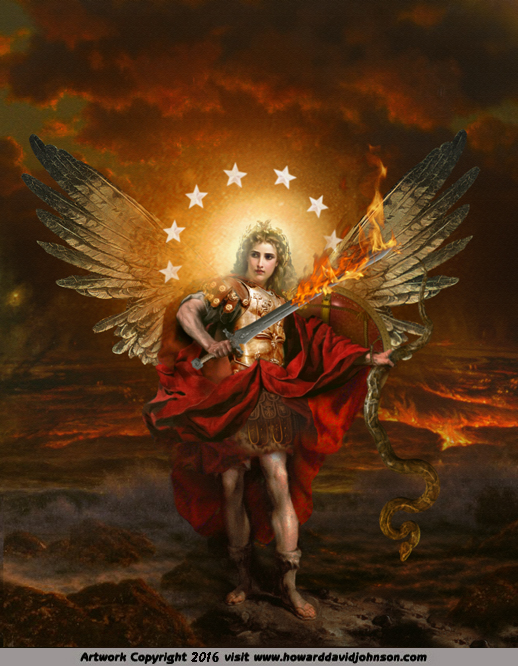
However great the
tendency to enlarge the number and the influence of the angels over
life, there is, on the other hand, great stress laid upon the fact that
the angels are in many respects inferior to man. Already Enoch (xv. 2)
intercedes on behalf of the angels, instead of having them intercede
for him; and none of the angels could see what he saw of God's glory
(ibid. xiv. 21), or learn the secrets of God as he knew them. When John
fell at the angel's feet to worship him in his account in The Book of
Revelation, (22:9) the angel said: "Don't do that! For I am thy fellow
servant just like you and your brothers
the prophets, as well as all who obey what is written in this book.
Worship only God!"
Pronouncements of
God's Judgment
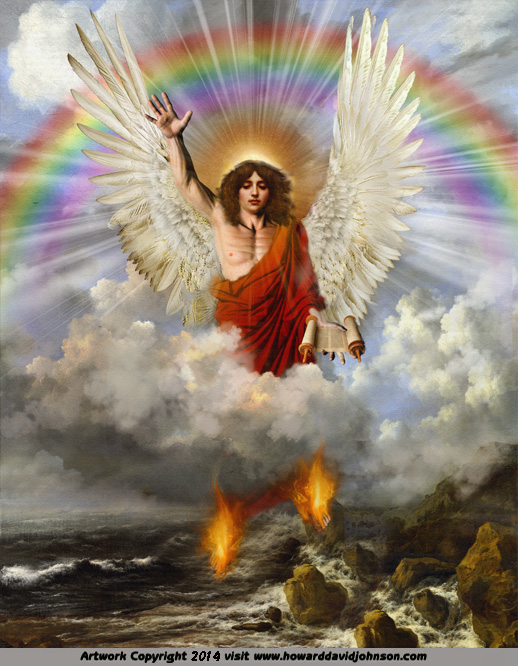
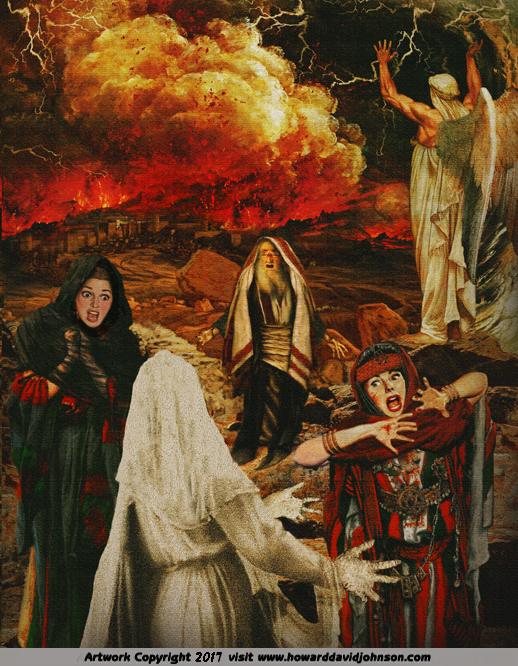
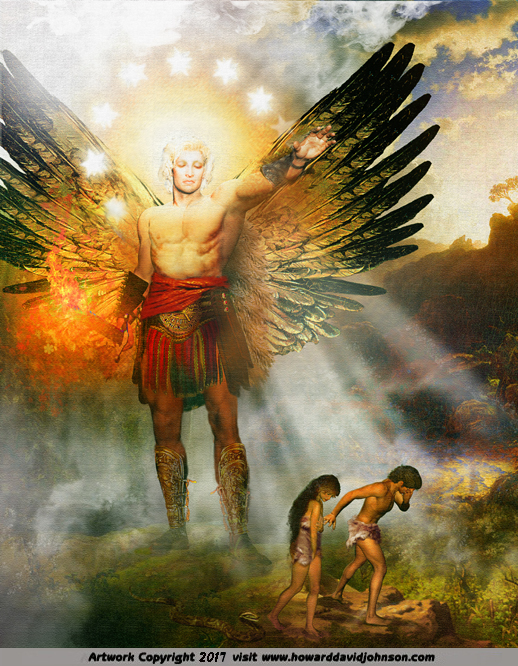
"The END of TIME"
MMXIV [left], "Escape from
SODOM" MMVII [center] and "Adam and Eve Expelled from the GARDEN of
EDEN" MMX [right]
Click on the Apokalypsis Banner to
see LOTS
more HDJ Angel Art~
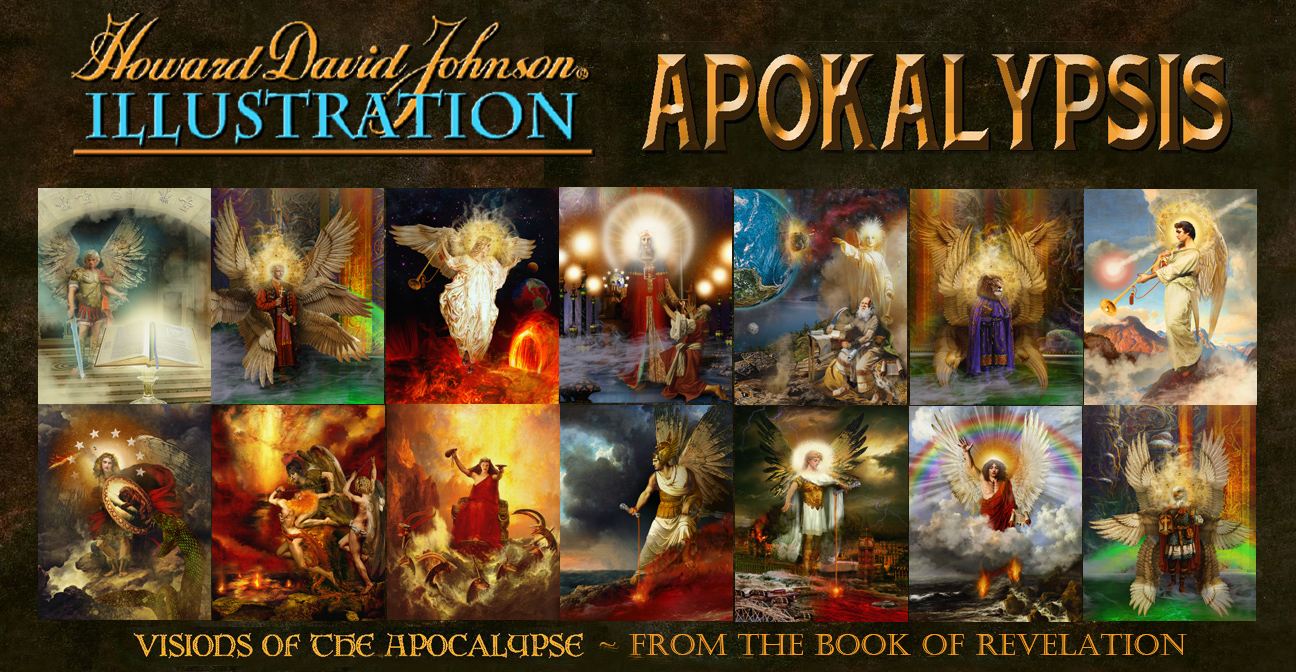








Thank you for visiting...
Bibliography:
For more on Angelology
and online copies of some of these rare books mentioned visit our
sources:
Julia M.H.
Smith, Europe After Rome: A New Cultural History 500-1000. Oxford:
Oxford University Press, 2005. Page 77 Tobit 12:15
James F. Driscoll, "St. Raphael" in The Catholic Encyclopedia (New York
1911)
The encyclopedia of angels, p.45, by Rosemary Guiley, Infobase
Publishing, 2004. The Talmud and The Q'Ran www.jewishencyclopedia.com
and
The Dead Sea Scrolls,
www.sacred-texts.com
and of course - The Holy Bible
*****
|
Enter a world of Beauty and Imagination...


The
Realistic & Fantastic Art of Howard David
Johnson
With a background in
traditional media including oils, pastels & colored pencils, Howard
David Johnson embraces leading edge digital media in the creation of
his depictions of fantasy, folklore, mythology, legend, religion, and
heroic history. He works
in a wide variety of media * Oil paintings * Acrylic Paintings *
Prismacolor Paintings * Drawings * Chalk & Oil Pastel Paintings *
Photography * 2D &3D Digital Artistry & Mixed Media *
|
|
INDEX of GALLERIES
Click on
these Fun Educational
Realistic Art Gallery link icons for Two-fisted Tales of VALOR
&
Frontline Combat featuring Legendary Warriors of History, Knights and
ladies of
Arthurian Legend, Celtic, Nordic, Asian and Olympian gods &
monsters,
unicorns, dragons, fairies... and more!
All these pieces of art and the text are
legally copyrighted and were registered with the U.S. Library of
Congress Office of Copyright by the author, Howard David Johnson All
rights reserved worldwide. Permission for many academic or
non-commercial uses is freely and legally available by simply
contacting the author via e-mail or visiting www.howarddavidjohnson.com/permission.htm
Who is
American Illustrator Howard David Johnson?
In one of
David's invitations to the
Florence Biennale Contemporary Art Exhibition, (a partner in the United
Nations'
Dialog among Nations), UN Secretary General Kofi Anon wrote him:
"Artists have a special role to play in the global struggle for peace.
At their
best, artists speak not only to people; they speak for them. Art is a
weapon
against ignorance and hatred and an agent of public awareness... Art
opens new
doors for learning, understanding, and peace among nations."
|
|
Howard David Johnson is
a contemporary realistic artist and photographer with a background in
the natural sciences and history. David works in a wide variety
of mixed media ranging from oil on canvas to digital media. David's realistic illustrations
have made appearances in every major bookstore and game shop chain in
America as well as magazines and educational texts around the
world.
Some of David's more prestigious clients have included the
University of Texas, the Universities of Oxford and Cambridge in
England, The Australian Mint, The National Geographic Society,
Paramount Studios, Universal Studios, MGM Studios, Warner Brothers Home
Video, ABC/Disney, CBS TV, PBS TV, The History Channel, Enslow
Educational Publishers, Adobe Photoshop, Auto FX, Tree-Free Greeting,
Verizon wireless, Apple IPOD, Penguin, Doubleday (Now Random House),
Harlequin Top Historical Romances, and the History Book of the Month
Club, as well as appearing in periodical publications like Popular
Photography and the Wall Street Journal.
|
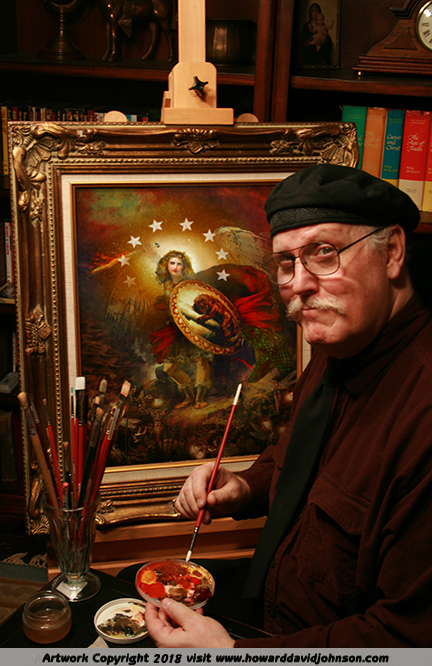
A Traditional style portrait
of the artist. [Photo by his son Erich.]
|
After a lifetime of
drawing and painting, David's
Traditional Art was exhibited in the British Museum in London in 1996,
( 3 years before he got his first computer ) as well as numerous
American ones since, such as the Metropolitan Museum of Art.
Working in a variety of
media David offers his customers a variety of options and more than
three decades of experience. As an illustrator he has not only used the
computer but has been involved in the development and marketing of
software for Adobe Photoshop. Digital art, Colored pencils, Pastels,
Mixed media, & also Oil Paintings can also be commissioned for
select projects.Digital illustration projects
start at $500.U.S. and group rates are available. David delivers custom
made copyright free illustrations & old fashioned customer service
when he does work-for-hire. To publish existing pieces of his
realistic art, David sells licenses starting at only $99.USD.
|
|
|






You can e-mail for more details at:
info@howarddavidjohnson.com
Your
business, letters and links are always welcome!
|
This Art Gallery
has been honored by more than
35,000,000 Unique Visitors
from the
Four
Corners of the Earth
My
Friends from around the world thus far :
The Russian Federation, Yugoslavia,
Macedonia, Croatia, The Czech Republic,
Bosnia, Herzegovina, Slovakia, Slovenia,
Luxembourg, Latvia, Estonia, Hungary, Bulgaria,
Lithuania, Poland, Austria, Romania,
Spain, Estonia,
Ukraine, Kazakhstan, Moldova, Malta,
Iceland, Finland, Norway, Netherlands,
Switzerland, Liechtenstein, Sweden, Germany, France,
Monaco, Andorra, Italy,
|
England, Canada,
Scotland, Wales, Ireland, The Vatican
City State,
Greece, Macedonia, Cyprus, Turkey,
Belgium, Denmark,
The Faroe Islands, Greenland, Portugal,
Albania, Armenia, Georgia, Slovak Republic,
Azerbaijan, Belarus, Kazakhstan, Gibraltar,
Israel, Palestinian Territories, Egypt,
Libya, Mali, Algeria, Niger, Saudi Arabia,
Oman, The United Arab Emirates,
Kuwait, Bahrain, Qatar, Yemen, Iraq,
Iran, Jordan, Syria, Lebanon,
Morocco, Ethiopia,
Eritrea, Liberia, The Republic of
Congo, Rwanda, Kenya, Angola,
Ghana, The Ivory Coast, Zambia, Zimbabwe,
Sudan, Nigeria, Namibia, Sudan,
Uganda, Kenya, Eritrea, Tanzania,
Botswana, Malawi, Senegal, Djibouti, Cameroon,
Chad, Gambia, Mozambique, Swaziland,
Lesotho,
|

"St Michael the Ranger of the
Heavens" MMXXI
|
|
|
|
South Africa, Seychelles, Viet Nam,
Japan, South Korea, China, Hong Kong, Macau, Mongolia, Mauritius,
Singapore, Thailand, Cambodia,
Laos, Myanmar, Macau, Malaysia, Taiwan,
Nuie, New
Zealand, Fiji,
Cook Islands, New Caledonia, Vanuatu, American
Samoa, Australia,
Micronesia, Polynesia, Papua New Guinea, The Heard and McDonald Islands,
The Philippines, Guam, Palau, Cocos Island, The
Kingdom of Tonga,
Malaysia, Brunei Darussalam, India,
Pakistan, Afghanistan, Bhutan,
Bangladesh, Sri Lanka, Chagos Islands, The Republic
of Maldives,
Turkmenistan, Kyrgyzstan, Uzbekistan,
Tajikistan, Azerbaijan, Nepal,
Indonesia, Chile, Argentina, Uruguay,
Paraguay, Brazil, Peru, Aruba,
Venezuela, Bolivia, Suriname, Guyana, Aruba,
The Dominican Republic, Guatemala, Costa
Rica, Colombia, Trinidad and Tobago, Antigua and
Barbuda,
Barbados, The Virgin Islands, Saint Lucia, The
Netherlands Antilles, Panama, Northern Mariana
Islands, Saint Vincent & Grenadines,
Grenada, Ecuador,
Belize, Nicaragua, El Salvador,
Bermuda, Cuba,
Jamaica, Dominica, Haiti, Puerto Rico, Cayman
Islands, The Bahamas, Honduras,
Mexico,
Madagascar, Central African Republic, Ethiopia,
Gabon,
San Marino, Saint Kitts & Nevis
Anguilla, Burkina Faso, Equatorial
Guinea, Polynesia, Madagascar,
Mauritania, Burundi,
and my home,
The Great Free State of Idaho (USA)...
|
|
|
|
If your
home is not listed here please
e-mail and tell us where you're from...
info@howarddavidjohnson.com
Your
business, letters and links are always welcome!






|

[CLICK HERE] TO
BROWSE OVER 200 CHOICES
Gorgeous
ARCHIVAL Quality
Printing!

For
a LIMITED time and a LIMITED print run many of the illustrations
in Johnson's vast portfolio are now available!
|

LIMITED
EDITION
[of a maximum
1,000 prints per image]
PRINT-ON-DEMAND
Each inspected,
hand signed and numbered by the artist!
CHECK OUT
FAST WITH PAYPAL!

thejohnsongalleries@gmail.com
Sized to fit
standard frames!
20x16 inch image size
[508x406mm] & 14x11 inches [356x280 mm]

[CLICK HERE] TO
BROWSE OVER 200 CHOICES
ASK ABOUT GIFT
CERTIFICATES
|
Poster
Size Reprints!
[CLICK HERE]
FOR DETAILS
The Johnson
Galleries prints these "in-house" with our new state of the art Epson
7890 oversize printer on
Epson 200 year premium photo paper and canvas with Epson inks!

|






|
Bonus
Section:
Philosophy,
Art,
& Art Philosophy
Personal
Opinion Essays on
spirituality, and realistic art yesterday and today by the artist.
|
|
Essay IV
H. D.
Johnson worked as a scientific research consultant for the University
of Texas at San Antonio through the 1970's under the guidance of top
Texas Scientists illustrating reconstructions of Paleontology and
Anthropology, oddly enough, he then worked under the guidance of the
world's foremost Biblical Scholars for the Center for Judeo-Christian
Studies. The two dramatically different experiences back to back caused
him to wonder...
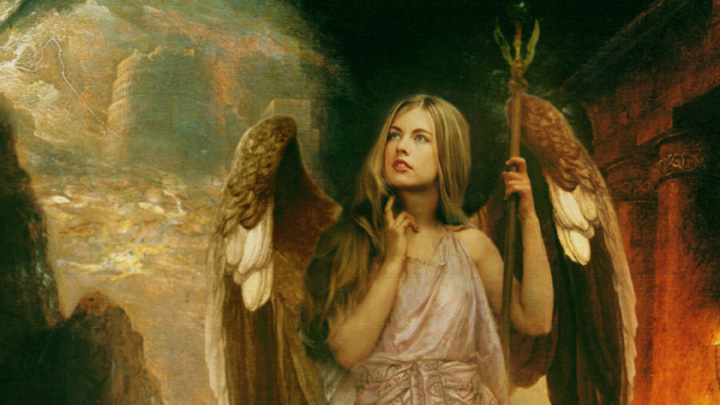
Has Science become a Religion?
a
brief essay applying the scientific method to religious studies by the
artist
"Believing
in God does not make you stupid; Galileo believed, Newton believed,
Einstein believed. Going against the consensus of the scientific
community also does not make you stupid- they all did! " ~ Howard
David Johnson MMX
|
|
With
respect to its great contributions to society, I think it is important
to make a case that science is really affecting society more like a
religion now than a field of study or a resource base of useful
information. Many everyday people do not understand it at all and
accept ALL its teachings on faith. Science is supposed to be a tool and
a path of study for the benefit of mankind and it is. I love Science
and greatly appreciate it's benefits. I feel strongly that many
scientists are heroes and deserve honorable mention and some truly
deserve places of great honor in the hallowed halls of history.
Breakthroughs in medical science are saving lives everyday in ways
undreamed of just to name only one of so many valuable fields.
Unfortunately some scientists have also been criminals or have brought
things into the world we all know about that we would have been better
off without such as thermonuclear weapons and pollution. I believe it
has also become things it should never have become. I shall
briefly try to explain what I have seen that has made me feel that
science is really affecting society more like a religion now than a
field of study.
|
The
major criticism of science with regards to The Bible has
been that it requires a leap of faith to believe that GOD created the
world, yet Science also has several leaps of faith of it's own. The Big Bang theory cannot
be proven as world renowned cosmologist Steven Hawking has stated and,
if it cannot be proven - believing in it - in Hawking's own words
requires a "Leap of Faith".
Until a theory is proven in a lab or in the field, it is
Philosophy, not Physics.
EVOLUTION IS
NOT A LAW OF SCIENCE. Darwin's
Theory of Evolution was proposed in 1859 and almost a hundred and fifty
years later it has still never achieved the status of a Law of Science.
This is because of the Missing Link. There is no proof of a link between man and ape, hence the
term "The missing link". This blind faith in Evolution has
been taught with religious dogmatism in the public schools for
generations and is still merely a theory. The Theory of Evolution, not the Law of
Evolution is a mere UNPROVEN hypothesis, which the dictionary
defines as "a
mere assumption or
guess or a proposition, or a group of proposals, offered as an
explanation for the occurrence of some specified group of phenomena."
Yet this "mere
assumption or guess"
is taught to children in public schools and young adults in colleges as
if it HAD been proven beyond any doubt. It was once a
Law of
Science that the atom was the irreducible particle of matter.
At Alamogordo, New Mexico in 1945 the atom was split and the atomic
bomb explosion in the desert blasted that Law of
Science out of existence.
Now, if a Law of Science is so unreliable, I ask you, why is a mere theory like
Evolution regarded so highly? Simple. It is about political control,
not about truth.
The
Missing Link
In
1912 A.D. a respectable geologist named Arthur S. Woodward and a lawyer
named Charles Dawson offered their new “fossil discovery” to the London
Geological Society. The “artifacts” included a thick portion of a human
skull, a fragment of an ape-like jaw, some animal remains and some
primitive stone tools. These items found in southern England in a place
called Piltdown were estimated to be 500,000 years old.
For 40
years the remains were accepted by the academic community as an
important part of our evolutionary development. Piltdown Man was
declared genuine and called the “missing link” between apes and man by
important scientists of the time. Because of this newfound “proof” men
of God were openly ridiculed as ignorant and improperly educated.
Piltdown man was debunked four decades later by chemical tests proving
the jaw and skull were not the same age, nor very old. It was a
DELIBERATE fake. The bones had been chemically treated and thoroughly
stained to make them appear prehistoric. Recognizable anatomical
features were broken off and filed down.
Why did this
fraud by lawyer Charles Dawson fool the experts? For many reasons, but
it was never seriously questioned because the scientists of the time
were delighted by the way it validated their evolutionist beliefs. For
more details of the debunking read: ”The Piltdown Forgery” by Joseph S.
Weiner, the classic account of the most famous and successful hoax in
science. The new and revised 2002 edition is commonly available. Today,
the term “Piltdown” is a term of ridicule, used to label fraudulent
research, but the impact on the lives of billions of trusting people
has had powerful political implications to this day.
The prover proves what the thinker thinks and
prejudice and political power seem more important than the truth or the
consistent practice of the scientific method. If truth were important
to them, they would use the scientific method when criticizing
The Bible but they do not. The scientific method requires going
to the source. Yet for these famous disparagements they use the King
James version instead of the original Hebrew. Translated in 1611 by
non-Christian King James of England for political reasons the K.J.V. is
one of the Colossal monuments of English Prose. The King James
Translation is not at all accurate enough to use as the sole source for
the defense of the Biblical Text.
Consider this example: One of the greatest conflicts between Science
and the Bible is the teaching that the world was created in six solar
days of 24 hours each. The word " yom" in the source, the original Hebrew text, which was
translated as "Solar Day" had 56 other choices. Modern English has more
than 60,000 words. Biblical Hebrew had 3,000. The average English
vocabulary has 6,000. My favorite choice of the 56 other options:" an
unimaginably long but complete period of time" harmonizes with science
perfectly. Another choice is: "time itself". So as we can see, going to
the source and using the Scientific Method brings very different
results than not going to the source.
Getting past this, the order in which life appeared was identical to
the theory of evolution's claims in the Book of Genesis, leaving us to
discuss the stars, the next main source of conflict between Science and
the Bible. The Hebrew text says "a swaddling band around the Earth
dissolved, revealing the stars. The Prover proves what the thinker
thinks. Here's a fun thought - What if GOD is in control of evolution?
What if it's his hobby? What if there is really no conflict between
Science and Religion? The scientists cannot disprove the existence of
GOD any more than they can prove the Big Bang happened.
Albert Einstein saw no conflict between science and religion. Like
Galileo, Newton and other immortal greats of science before him,
Einstein believed in GOD.
Therefore, I
present to you this idea: Modern Scientific beliefs are based upon a
leap of faith in the big bang theory. It has become a belief system
based on faith and therefore another form of religion. Scientists,
like priests can explain their beliefs but the everyday people accept
it all on faith. Scientists and doctors are the priests of this new
religion, getting angry and crying "heresy" when anyone respectfully
disagrees with them. I once had one of my supervisors in the UT
anthropology department explain to me for three hours on a research
expedition in mathematical terms how something could have ALWAYS
existed, needing no beginning point. When we agreed that the math was
good he then made a COLOSSAL leap of faith, saying "This proves the
Universe has always existed and there is no GOD." In one second I
countered;" I could just as easily jump to the conclusion that this
proves the existence of an eternal GOD." It is this "jumping to
conclusions" or as Steven Hawking put it; "making leaps of
faith." that infuses philosophy with their physics. Then there is
the infusion of politics; a perfect example is
The
Myth of Carbon 14 dating:
Educated
people know that carbon 14 dating is totally irrelevant to the theory
of evolution. Scientists never state that carbon 14 dating offers proof
for the theory of evolution. Ignorant evolutionists, however, believe
carbon 14 dating proves the theory of evolution, and stubbornly make
that claim based on faith in what they were told in our learning
institutions. They were DELIBERATELY lied to to gain POLITICAL POWER. I
will explain; Carbon 14 dating is ONLY reliable for five thousand years
as even its creator himself admitted in 1972. Carbon 14 or Radiocarbon
Dating was first
devised in 1949 by Dr. Willard Libby. It is based on the rate of decay
of carbon 14 or its "half-life" of 5730 years. This method offers
reliable dates up to 5,000 years ago, but its results require
correction since Dr. Libby's belief that the levels of carbon-14 in the
atmosphere were identical through the ages has long since been
disproved. Volcanoes and floods for example skew the results to the
point where guesswork or leaps of faith are required even in dating
organic material from historic times. Dr. Libby once expressed his shock when he found that
radio carbon dates for human artifacts extended back only 5000 years
and older dates were found to be unreliable. [W.F.Libby,
`Radiocarbon Dating', (Chicago, 1952), pp. 4-9] [CRSQ, 1972, 9:3, p. 157]
By
this time tens of thousands of C-14 dates had been published from tests
in laboratories around the world. The textbooks and curriculums have
yet to be revised. Instead, a MYTH is being taught in our
schools. There are exciting new methods but wild guesses about
the amount of Carbon 14 in the atmosphere do not PROVE anything.
Believers in GOD are called foolish and ignorant on the political
strength of this deliberate lie that Carbon 14 dating proves evolution.
The gross
disrespect and intolerance I have seen of certain members of the
scientific and academic communities and their disciples toward anyone
who disagrees with them is just as arrogant and abusive as racial,
sexual, religious, or any other kind of prejudice.
Here's
a great example: Around 1910 in educated circles it was considered a
mark of ignorance to believe the Biblical record. There was little
scientific evidence available then to support the Bible's claims and
academic circles decided that was the end of the matter and as the
decades moved on, the scientific and academic communities stubbornly
ignored tidal waves of new SCIENTIFIC evidence. One excellent
example is in what the Bible says about Abraham. In the early
20th century experts in the field of archaeology insisted that no
civilization even existed in UR of the Chaldeans when the Bible records
that Abraham lived there. On the basis that no evidence was currently
available they declared Abraham a mythical character.
20th century evidence however has proven beyond any question the
existence of an advanced civilization in UR of the Chaldeans during the
21st and 20th centuries B.C.-That was Abraham's day! Abraham's
historicity is also confirmed by ancient inscriptions that bear the
names of almost very town mentioned in Ch. 12-14 of Genesis and one
even has his father's name. Archeological discoveries also show these
towns were in existence until about 2,000 B.C.- but not later!
No
longer can the Bible's critics get away with accusing us of being naive
or foolish today when we believe what the Bible says about Abraham like
they used to in the 20th century.
This
is critical to the belief systems of the world's great monotheistic
religions Islam, Judaism and Christianity who all claim ascendancy from
Abraham. Why isn't this commonly taught in schools? Many scientific
professionals openly abuse the authority of their positions to push
their personal beliefs and ignore the confirmed scientific
data to hold on to political power. Other Biblical confirmations
from modern Archaeology include: Date and manner of Jericho's fall, The
exodus from Egypt, Major characters from the book of Daniel and many
others. The SCIENTIFIC proof is all there waiting for you if you take
the time to look it up.
Certain scientists and academics like to act like they
know everything about the origins of the Earth. They don't. Many of our
long taught ideas about planetary science have recently been proven
completely wrong. Did you know that The Gas Giants on the outside of
our solar system and the surface of the Planet Venus are DRASTICALLY
different than what I was authoritatively taught about them as a boy in
school? If
they can't even tell us reliably how the solar system is today how can
we rely on their ideas about its distant unobservable origins?
Yet even in the face of constantly
changing SCIENTIFIC evidence most scientists are prone to UTTER
DOGMATISM about their belief system. Science is supposed to be
the sum of the best knowledge we have
at the time - incomplete but always learning, always growing- but
sometimes making serious mistakes. Why admit things were COMPLETELY
wrong about planetary science within the solar system but
NEVER MENTION the discovery of the unreliability of Carbon 14 dating
or the discovery of archaeological
evidence
of Abraham being a historical figure? Simple. There is no danger to the
foundation of the belief system of this new religion or it's social and
political power base.
Mankind's only hope for continued survival on this planet is to
learn to tolerate each others differences and live in peace with one
another and in harmony with the environment. We're all in the same
boat...
I do not believe that scientists should be
exempt from this challenge to be tolerant, since they created
the very things that could well destroy us, such as thermonuclear
weapons & pollution.
We all have a lot of work to do if we are to
survive. I write this in defense of my faith and of the faiths of
others which have been disparaged by these attacks on the sacred
writings of the world's great religions...If we're going to have
a better world we're going to need both better leaders and better
citizens.
I personally believe that any belief in a
higher power that must be answered to makes us better citizens than if
we believed that we are the ultimate life form in the Universe.
~ H D Johnson 2007
|
|
|


CLICK ON THESE LINKS OR E-MAIL
FOR THE JOHNSON GALLERIES' VARIOUS BUSINESS SERVICES:






info@howarddavidjohnson.com
Thank you for
visiting the Angel Art gallery of Howard David Johnson
*****
|
|
Essay
and Articles Section:
Philosophy,
Art, & Art Philosophy
Personal
Opinion Essays on Realism yesterday and today by the artist.
STYLE and
TECHNIQUE
Howard David Johnson is an outspoken proponent of
mechanical aids to visual art. Unlike the opponents of mechanical aids,
his mission is not to prove his talent but to help preserve our
vanishing Western cultural heritage. In addition to his mastery of the
traditional media, now combines drawing, painting, photography, and
digital media with more than thirty years of experience in these fields
to create his Realistic Art Numerica in 21st century paintings and
pictures. Did you know the
Greek word "Photography" means "Painting with Light"? Today with the
advent of computers it truly lives up to it's name. Due to developments
in Art and Technology, a broader definition of painting is needed than
that which is found in common usage. Introducing Art Numerica-
an exciting merger of traditional visual art and cutting edge
technology... a new art form for the twenty- first century... Art
Numerica is not limited to realistic art but also offers limitless
horizons for everything from cartoons to abstractions.
It
is the most dramatic development in the visual arts since the
Renaissance.
|
| There is a
school of thought that seems to think that a caveman’s beating on a
hollow log with a stick is automatically superior to Beethoven’s Ninth
Symphony performed by the world’s finest symphony orchestra because
less technology is involved. I do not subscribe to this kind of
thinking. Personally I LOVE computers! First of all, there’s the
freedom from fear! The undo button is empowering and liberating!
More importantly, publishing customers can't afford to pay me for old-fashioned
traditional methods like oil on canvas. I can do them, and do them
well, but no one but millionaire art collectors can afford to pay even
poverty level hourly rates for all that time. The masters often took a
year for a single painting. With digital media I can create pieces that
look very nice for very nice prices and with blazing speed. The
publishing industry is not noted for its patience. In the early days of
my art career, mailing traditional media originals was scary at best,
but now they can be scanned and shipped without risk. Also in my early days adding canvas space to a work in
progress was as impossible as growing a second head... but now it is so
easy I usually don't even charge extra to adapt them if its just skies
or landscapes! Re-dos and revisions were financially catastrophic! No
wonder the starving artist became a stereotype! Before the internet, I
struggled to find customers in Austin Texas, now nearly every nation on
Earth has visited my website! This was beyond my wildest imaginings as
a boy. What an amazing era we live in! I love it!!!
~ Howard David
Johnson
|
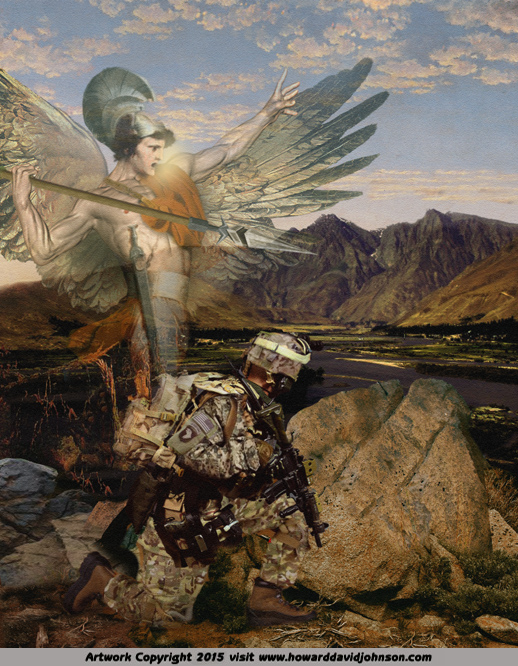
|
ABOUT THE ARTIST:
| Howard
David Johnson is a contemporary visual artist and photographer with a
background in |
| the
natural sciences and history. He works in a wide variety of media
ranging from traditional |
| oils,
pastels and others to cutting edge digital media. He loves mixing
media. This site features |
| examples
of his Realistic Art, including illustration, photography,
experimentalism, and fine art |
|
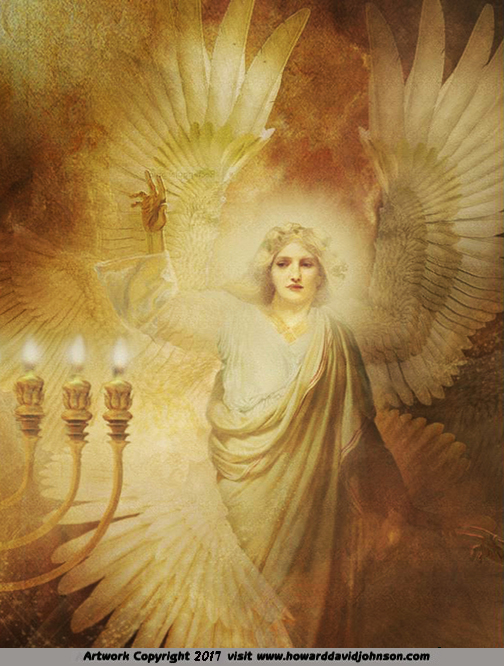
"The Seraphim"
|
The
various galleries linked to by the icons above show many examples of
His Realistic Art, and are grouped by theme rather than media. Since
boyhood he has passionately copied the old masters. Using a strategy
employed by J.W. Waterhouse (The old master David has imitated most) -
his wistful and graceful models cannot be underestimated in their
contribution to the stunning beauty and the potential for lasting
appeal of his work. To create his work, he usually starts with a
thematic concept, then working in his Photography studio with live
models. He then assembles a variety of elements which are realistic and
original. As a boy he dedicated his life to art in 1960. From
1965- 1999 he used xeroxes and tracings to make his preliminary photo
montages. This is patterned after the manner used by Maxfield
Parrish and other 19th century notables. For this he offers no apology
as many of the greatest artists in history employed any and all means
of technology at their disposal such as Camera Obscura or even the evil
manufactured tube paints. See his article below:
"On Art and Technology: When Seeing is Not Believing"
An essay dealing with mechanical aids to visual art from Camera Obscura
to Computers for more on this. The
digital montage is a natural evolution of the preliminary photo collage
David learned from great Realistic illustrators like Maxfield Parrish
and Norman Rockwell. You'd think by now everything would have
been tried but it hasn't. Exploring new art mediums is just as exciting
today, just as full of freshness and newness as it ever been.
|
|
His favourite medium for professional work for many years was colored
pencil because of the high speed and low expense, and people began
expressing difficulty in telling his colored pencil drawing from
photographs in the early 1980's. Lately he mostly draws in colored
pencil to relax and for personal works. Recently he has come to prefer
Oil on canvas and digital media because of the respectability of oils
and the flexibility and profitability of digital media. As a
commercial illustrator Johnson has not only used the computer to create
art but has been involved in the development of computer imaging
software for Adobe Photoshop. Working in a realistic style inspired by
classic illustrators David is deeply rooted and grounded in the
Greco-Roman artistic tradition, Feeling that with realistic art, the
human form is the ultimate arena for artistic expression. His lifelong
dream came true when his Traditional Realistic Art was exhibited in the
British Museum in London England in 1996. Having achieved international
acclaim as a traditional visual artist he discovered digital media (Art
Numérica) in 1999. Because of his passion for realistic art he
elected to embrace it and joyfully be a part of this historic era in
the visual arts as a 21st century realistic visual artist.
|
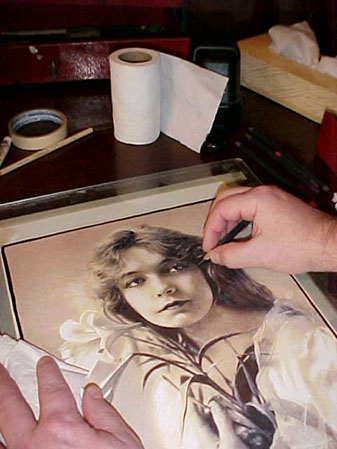
Click this image for
information about private lessons
|
Since 1972 when he began his career as a scientific
illustrator for the University of Texas he has earned his living
illustrating all kinds of books, magazines, CD covers, and all sorts of
games, greeting cards, calendars, portraits, tapestries, murals and the
like with his contemporary realistic art... David's Realistic Art
has appeared in every major bookstore chain in The United States and
has been used in educational texts and magazines all over the world.
*****
|
|
Essay Section:
Philosophy, Art, & Art Philosophy
Personal Opinion Essays on Realism
yesterday and today by the artist.
"Those who are enamoured of
practice without science are like a pilot who goes into a ship without
rudder or compass
and never has any certainty where he is going. Practice should always
be based upon a
sound knowledge of theory, of which perspective is the guide and
gateway, and without it
nothing can be done well in any kind of painting."
Essay One: "THE MORE THINGS
CHANGE, THE MORE THEY STAY THE SAME..."
(A Brief essay dealing with attitudes
toward Traditional Realistic Paintings, Pastels, Colored Pencils and Art
Numérica )
|
"Painting,
in art,
the
action of laying colour on a surface, or the representation of objects
by this means.
Considered one of the fine arts"
~Encyclopaedia
Britannica.
"Painting.
noun. 1.) The act
or employment of laying on colors or paints. 2.) The art of forming
figures or objects in
colors on canvas or any other surface, or the art of representing to
the eye by means of
figures and colors any object; the work of an illustrator or painter.
3.) A picture; a
likeness or resemblance in shape or colors. 4.) Colors laid on. 5.)
Delineation that
raises a vivid image in the mind; as in word painting.
~
Webster's Unabridged Dictionary
of the English Language
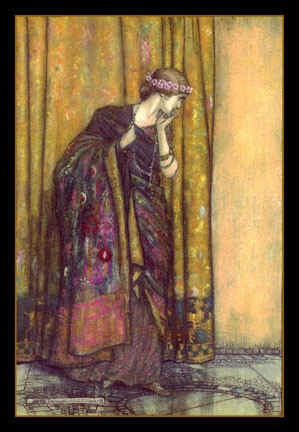
Pastel, Acrylics, and
Colored Pencils combined
|
Snobbism in the arts is nothing new. Some people will tell
you that oils are the only valid medium for realistic paintings. That
Colored Pencil, Digital, and other Realistic Painting and Drawing Media
are not valid for "real" art. Young artists, Don't let them
bother you. Their forerunners used to condemn Pastels before they
gained acceptance and called them "crayons" when Johann Alexander
Thiele (1685-1752) invented them. Mercilessly disrespectful
art critics of the time could not stop the Experimentalists no matter
how viciously they attacked and derided them. "Crayon-painting" as it
was called in England was practiced early on by persecuted pioneers in
Switzerland and many other nations. What a debt we owe to these master
artists who refused to knuckle under to the pressure of those
short-sighted critics during those historic and experimental times. It
took until 1870 with the founding of the "Societe` Des Pastellistes" in
France that respect came at last to these heroic & immortal
visual artists.
|
|
In England the liberation of the Pastellists from slight regard
and undeserved disrespect came with the first exhibition of "The Pastel
Society" at the Grosvenor Gallery in 1880. Pastel Painters like
Mary Cassat and others from America and other nations forever
silenced the snobs with their masterworks and gained recognition
at long last for Thiele's invention as a valid art medium. I am
persuaded that history will repeat itself. Like Pastels, I
believe these wonderful new colored pencils and even Digital Realistic
Art Media will one day receive the recognition they deserve as powerful
mediums of artistic expression just as pastel paintings did. What is
your definition of art? Have you thought about it?
Mine
is: "anything that makes you feel or think."
Consider dancing... it can be a little skip in the step or rise to the
level of the incomparable Russian Ballet. Did you know that just the
materials alone for a single oil painting cost up to a thousand dollars
these days? Even paying the artist less than minimum wage no one but
the super rich can afford them anymore. Something's got to give.
Realistic paintings in oil have been highly prized for centuries and
the appeal and following of realistic art is undiminished to this day.
Oil paintings featuring Abstract Art and Realistic Art are generally
the most treasured form of all the visual art media and with good
reason. But snobbish art critics favoring abstract art have
declared that realistic paintings, or illustrations are not art
for a century. With so many representationalist paintings by so
many immortal master artists hanging in the Louvre, the Hermitage, and
the British Museum and others I think the disrespect for realistic
illustrators that dominated the 20th century is academically ridiculous
as well as vain and intolerant, insisting theirs is the only valid
opinion. What is your definition of Art? I believe almost any
form of human expression can be raised to the level of "high art"
especially visual art and Realistic illustration...
|
|
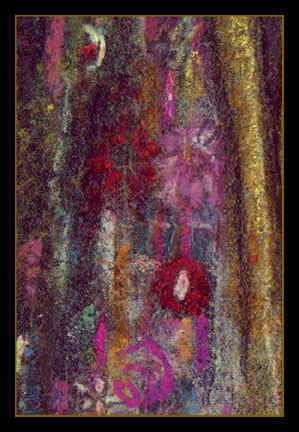
The
detail reveals Realistic art and abstract art combined
|
By my own definition of art, which is: "anything that
makes you feel or think" most abstract paintings are not "real art" to
me personally, because abstract paintings usually
neither make me feel or think, usually focusing obsessively on
technique and avoiding any coherent content. I usually draw a complete
blank mentally and emotionally when I look at them. In 1979 the Houston
Metropolitan Museum of Art displayed a triptych of 3 giant
paintings they paid fifty thousand dollars for- three blank white
canvasses entitled "untitled". Then there was "The incredible new
artistic Genius" with an I.Q. of 62 ...Congo the chimpanzee with his
gala New York art exhibition...an elaborate prank played on the
Snobbish American Art critics about a generation ago by research
scientists in the field of primatology. Imagine how upset they were
when he created one of his "ingenious masterpieces" right before their
eyes.
(
My Source for this is the Time Life Science Library volume entitled
"The Primates". )
|
|
Art education has been almost completely removed
from American Schools as a result of generations of this kind of
fabulous nonsense contributing to America's cultural illiteracy crisis.
Now, the works of Leonardo Da Vinci, Michaelangelo, and other notables
are being removed from school libraries. After generations of
this, most American college graduates today cannot name even one living
visual artist, abstract or realistic.
There
is no way that mandating more math, requiring more reading, or
scheduling more science will replace what we have lost as a
culture.

What
is your definition of Art?
~HDJ
*****
|
| Note: Abstract
Paintings by Congo the Chimpanzee outsold Warhol and Renoir by over
25,000 dollars in June 2005 at a London art auction. Born in 1954,
Congo created more than 400 drawings and paintings between the ages of
two and four. He died in 1964 of tuberculosis. There is no precedent
for this kind of sale.
|
|
Essay Two :
The Rebirth of Realism
More
thoughts on realistic art
yesterday and today by the artist
Art
History
has entered a new era with the birth of Art Numérica, or digital
art media in the 21st century. Artists never stop exploring with
mediums. Artists have
been developing techniques, experimenting with different tools since at
least twenty- five
thousand years ago, when the first artist picked up a charred stick and
scratched a
picture out on the wall of his cave. You'd think everything would have
been tried by now,
but it hasn't. Exploring new mediums this very day is just as exciting,
just as full of
freshness and newness as it ever was.
|
|
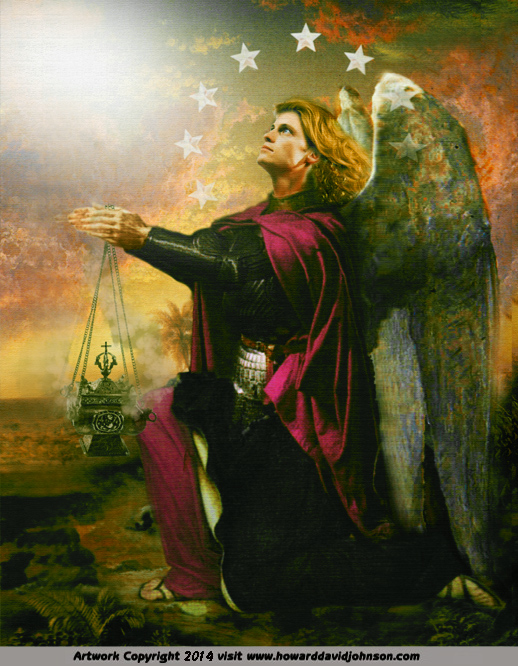
|
The creation of Realistic art has been
the goal of most artists since the dawn of civilization.
Realistic art was the pride of ancient Greece. The world's greatest
museums are full of realistic art. Realistic art WAS art until the
advent of the abstract expressionist movement in the twentieth century.
The coming of the camera in the nineteenth century changed realistic
art forever. Suddenly, realistic art was not the only way to create
realism in portraits and historical records. The work of the realistic
artist was suddenly made into an expensive luxury. The political power
of the realistic artist was broken and they were no longer an
indispensable member of society. Hostility to the creators of
realistic art goes back to ancient times and the jealousy of advisers
to the Pharaohs and others who were not able to spend as much time with
their rulers as their portraitists. Although with the aid
of photographs, realistic art achieved levels of excellence undreamed
of, the realistic art movement of the late nineteenth century was
short. None of these people earning their living creating
realistic art could compete with the speed and low cost of photographic
portraiture. Determined to survive, great realistic artists like
Pablo Picasso ingeniously turned inward and began to explore things
that could not be photographed in a new school of art, abstract
expressionism. |
| The day of the fine art superstars had
arrived. It was now largely just a hobby to abstract and realistic
artists alike. Illustration, because of advances in printing technology
enabled an elite few to earn a living with their realistic art. These
illustrators working in realistic art media were condemned and
ridiculed in much the same way Europe's great symphonic composers were
condemned for working in motion pictures after fleeing the nazis during
World War Two. The rift between realistic and abstract art grew wider
and wider. The universities and key media usually sided with the
abstract camp and derided anyone working in any realistic art media
declaring boldly that realistic art was not "real" art. Immortal giants
of realistic art such as Maxfield Parrish were mistreated their entire
lives. They were accused of selling out for creating beautiful pieces
of realistic fine art to earn a living. The attitude that the true
artist must suffer and starve and die in poverty became a rule. There
were the Abstract art superstars, the professional realistic
illustrators, and the hobbyists who, although cut off from gainful
employment and social influence still recognized their artistic gifts
as a calling rather than a profession. |
Early abstract art masters proved themselves as
realistic
artists before delving into realms of the intangible. They had to do
this at that time to
prove themselves because of the challenges they faced from the
establishment for going
against the status quo. In the latter part of the 20th century,
realistic artists like HDJ
were challenged to do abstract art to prove themselves as shown in the
example above
(Deirdre of the sorrows). Later realistic art training was abandoned in
most schools and
things like splattering paint in fits of rage were deemed more
than enough. By the
end of the 20th century something as destructive and ridiculous as
nailing a pack of
cigarettes to a shoe was considered fine art but not realistic
paintings. Fashions in art
have often been as silly as fashions in ladies hats. As the
century drew to a close,
many people had had enough. The realistic revolt was at hand. The
rebirth of realism was
fueled by the advent of the digital era. Now, for the first time in
almost two centuries,
an artist or illustrator could earn a decent living again with his
realistic art. This is
historic. Realistic art is not going to go away, especially now that
photography has
truly merged with traditional realistic visual art. Photography comes
from the Greek words
meaning "painting with light". Now with the advent of digital media the
capability of realistic art has become almost limitless, truly,
"painting with
light". The merger of all the world's art forms to realize the
potential of motion
pictures has come now to still realistic art media. This website for
example, combines
music, prose, poetry, photography and traditional realistic art media
to create an
experience beyond merely looking at realistic paintings.
The twenty- first century is already seeing a new renaissance in the
arts
because of the world wide web. There has never been anything like it.
Abstract art,
computer art, photographic art, and realistic art are continuing to be
separate schools of
art but are also blending to create exciting new horizons. Although
Digital art does offer
completely new horizons to the artist in the 21st century it does not
mean the end of our
time honored art traditions. Instead, it offers additional ways to keep
these traditions
and schools of thought fresh and alive.
~
HDJ
*****
Essay
Seven: NEW!
On
Art and Technology: When Seeing is Not Believing
An
essay dealing with mechanical aids to visual art from Camera Obscura to
Computers
When the
camera was finally made commercially available in the 1830's it
exploded on the world
scene and sent shockwaves through the art world as history had never
seen before. Visual
artists all over the world were suddenly put out of work and resentment
and outrage
followed. Suddenly much more realistic portraits could be had at a tiny
fraction of the
cost of a painting and delivered almost instantly. The art world would
never be the same.
When motion picture cameras were new, seeing was believing and human
consciousness changed
forever in the 20th century. Sometimes even Terror and Panic came from
the initial shock!
In 1905 cinema patrons defecated and urinated in their seats as they
broke each other's
arms and legs desperately fleeing for their lives from a crowded
theater to escape a train
charging straight for them! ... train footage filmed safely from a
bridge with a camera
lowered down on a rope. A modern cinema patron would not even feel
uncomfortable. The
Photograph and its manipulations have changed human consciousness and
history... and will
continue to do so in the future.
The
Camera has changed everything.
The Camera of Today owes
it's origin to the Camera Obscura, a light- tight box with a lense and
a screen that
receives an image. This device has been used by artists since ancient
times to trace the
projected image of whatever they set before it on a screen. Intrigued
by the idea of
producing a permanent light-formed image instead of reproducing it by
hand, a long line of
inventors studied the problem and successively made contributions to
the solution.
Photography was neither
discovered nor invented by any one man. It was the outcome of the early
observations of
the alchemists and chemists on the action of light, a subject that
belongs strictly to the
domain of photochemistry. Although the blackening of silver salts was
known in 1565, it
was not until 1727, when Johann Heinrich Shulze of Germany used a
mixture of silver
nitrate and chalk under stenciled letters, that it was definitely
recognized that this
darkening action was caused by light and not by heat. In the years that
followed
experiments with silver nitrate on leather and wood were successful. In
1817 J. Nicephore
Niepce first tried photography with silver nitrate and paper. In 1826,
L.J.M. Daguerre, a
painter who had experimented with silver salts approached him and
formed a partnership.
Daguerre discovered
accidentally that that the effect produced by exposing an iodized
silver plate in a camera
would result in an image if the plate were fumed with mercury vapor.
The Daguerreotype
process was a complete success. These chemical processes would be
improved again and again
until the advent of the digital camera we know today. The
attitude that Photography
was not art and was a purely mechanical process requiring no talent
whatsoever was put
forth with great force and hostility in an attempt to get people to
refrain from choosing
it for their portraits instead of paintings. This is a typical reaction
to new technology,
when Pastels were first invented they were dismissed as a child’s
plaything rather
than a viable art medium. These attacks on new technology are not
limited to the arts of
course. When the Wright brothers were making history at Kitty hawk with
the first manned
airplane their detractors said: "If man were meant to fly, he'd have
been born with
wings." This kind of negativity is just human nature to some kinds of
people.
Photography
came into being through an
artistic, not a scientific urge. Daguerre was an artist, a scene
painter whose
illusionistic diorama was a landmark in Paris long before his name was
connected with
photography. Critics were merciless as usual, with scathing
condemnations of the media.
However, in the hands of a sensitive artist, photography quickly showed
it's artistic
possibilities. David Octavious Hill, a Scottish Painter invented the
camera set up and the
pose as we know them today in the 1840's and was the first of a new
breed of master
photographic artists. Photography was here to stay. Diverse forms of
retouching techniques
followed both by accident and by design and took the medium to new
levels of artistic
excellence. Now, more than a century and a half later only an
uneducated or blindly
hateful person would say Photography is not an art form. Of course
we've all seen our
share of awful pictures with the heads cut off taken by amateur
photographers but we've
also seen the work of studio masters like the great portrait
photographers from Hollywood
in the 1930's and forties. Anyone who has tried to create such a
sophisticated studio
photograph realizes quickly that this is a very difficult art form to
master even if a
trained orangutan can take a bad snapshot with an instant camera made
for children.
The use of
Photography as a mechanical aid to
traditional oil paintings and other forms of realistic art came right
away. This is not
surprising since artists had been tracing from Camera Obscura for
thousands of years.
Famous Myths; Leonardo Da Vinci ( 1452-1519 ) is often credited with
the invention of
Camera Obscura because he used it for his masterworks during the
Renaissance and mentioned
it in his notebooks, but this is simply not true. Similarly, Americans
are credited with
the camera, but it is also not true. Origins: Unlike the camera, the
inventor and time of
invention of Camera Obscura are unknown. Perhaps a crude form of it was
known to the
ancient Greeks, but there is no material evidence to substantiate such
a point of view.
The mathematical precision and perfect anatomy of Greek art combined
with their passionate
love of science and mathematics is testimony enough for many scholars.
The earliest clear
description of Camera Obscura occurs in the great optical treatise of
the Islamic
scientist Al-Hazen who died at Cairo, Egypt in A.D. 1098. His Opticae
Thesaurus ( Book of
optics ) was rendered into Latin sometime during the 12th or 13th
century by an unknown
translator. Al- Hazen honestly declares that he himself did not
discover it, so we know
from this it had to have been masterminded before A.D. 1098.
| Camera
obscura is a device for tracing or sketching large objects. It consists
of a box painted black inside- a mirror at a 45 degree angle , and a
lens, like that used in a photographic camera. An image is thrown on
the mirror by the lens and reflected on the screen, where it can be
sketched with tracing paper. The Camera Obscura was in general use by
newspaper and magazine illustrators until it was replaced by the
photographic camera. Make no mistake. Professionals have been using
mechanical aids since the first caveman shaman traced his hand out on
the wall of his cave. The view finder on the reflex camera is a
development from Camera Obscura. Camera obscura, interestingly enough,
is Latin for "darkened chamber". |
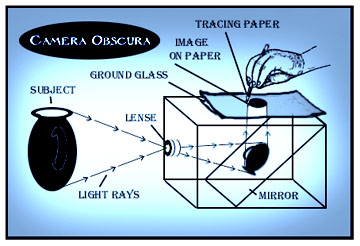
|
In
the early 1600's the telescope came into use and Camera Obscura spared
viewers the harmful
effects of gazing directly into the sun. I regret, but that we must
acknowledge the fact
that almost every art medium throughout the ages has been corrupted. In
the 2nd century,
the Roman emperor Hadrian had the head of his lunatic predecessor Nero
removed from a
statue and replaced by that of his favorite. Much later in 1539,
Holbein painted a
glamorous and flattering portrait of Anne of Cleves for Henry VIII.
When the future queen
arrived in England, King Henry met the surprisingly less than dazzling
and glamorous Anne.
His disappointment made history. Our modern society certainly can't
claim t he honor nor
take the blame of being the first to manipulate art forms.
By the 21st century instead of the traditional assistants and
apprentices, artists
employed overhead transparency projectors, opaque projectors,
artographs, light tables,
slide projectors, color photocopying... and suddenly, computers and
image editing
software, which brings us to some very compelling controversies
regarding these modern
imaging technologies and their impact on various media and further
changes to human
consciousness. For example: The integrity of Photography as evidence in
our courts of law
stood for many decades until it was shattered by the digital
manipulation of photographs
and new standards needed to be introduced. Websites sold peeks at
photos of
celebrities' heads pasted onto photos of wild women in scandalous poses
for all the world
to see- but advertised as real celebrity pix. Scandal rocked television
and other news
media when digitally altered photographs were being passed off as
reliable evidence of
important news stories...
On a positive
note, no one was threatened by how this technology enabled motion
pictures to do epic
things they could only dream of before. They were supposed to be
make-believe images
appearing real! A golden era in special effects cinema ensued. Then,
this powerful digital
imaging technology, like the camera, fell into the hands of the common
man through
computer programs like Adobe Photoshop. A new culture of skepticism had
abandoned the age
old adage; "seeing is believing" Photography has never told the whole
truth,
just parts of it. Photography is also an art form and therefore
rightfully susceptible to
creative alterations. In addition, the advancement of digital
manipulation technology
cannot be undone or halted. I believe that we must recognize that this
digital technology
exists on a gigantic-scale, and will never go away. Therefore, I
suggest that digitally
altered photos are distinct from traditional photography, and should be
treated as such.
Contrasting
views: anti-manipulation
advocates’ fear a negative impact of digital manipulation in a court of
law, and
pro-manipulation advocates say that we must wake up to the fact that
for for decades
pictures have not been reliable evidence in court and that any good
lawyer will attempt to
discredit photographic evidence. In response to claims that photos
should always tell the
truth, the pro-manipulation camp would say that photos have never told
the unvarnished
truth. A camera shows, and has always only shown, a fraction of
reality, and even then
what we see is taken out of context or even fabricated. Photography
from its onset has
been subjected to modifications. In 1839, the Frenchman Louis-Jacques
Daguerre patented
the daguerreotype, or what could be called the first "picture." Simply
explained, the daguerreotype combined the usage of the camera obscura
and silver iodide to
produce a permanent image on a copper plate. A very exciting
innovation, Daguerre boasted
of it, "With this technique, without any knowledge of chemistry or
physics, one will
be able to make in a few minutes the most detailed views"
("Photography").
Almost immediately, the daguerreotype, especially daguerreotype
portraits, became
immensely popular. Its popularity, of course, can be attributed to its
novelty, but also
because people believed the daguerreotype produced a more real image
than a painting. The
general attitude toward the daguerreotype was that it could create
images more
realistically because there was no artist to interpret and modify it in
his own style.
Opponents
of Digital Manipulation insist Photography should always represent the
truth, asserting
Photography's first and foremost function is to portray reality.
Many assume that
photographs have never been manipulated, and that this recent outbreak
in digital
technology damages the integrity of photography. Without delay,
anti-manipulation
proponents demanded an end to all "dishonest" photography, as it
severely
misleads the public. Also, they view digital manipulation as a purely
mechanical process,
with no talent or skill involved. Furthermore, anti-manipulation
proponents fear
manipulated photos might acquit murderers or rapists in courts of law.
The thought that
photography had replaced painting abounded. "As if photography needed
to absolve
itself from its ‘original sin’--of having brought about the death of
painting", a movement known as pictorialism thrived around 1890-1914,
the Art Nouveau
period. Proponents of pictorialism primarily set out to gain the
recognition of
photography as an art rather than just a mechanical process. The
pictorialists fashioned
bizarre and oddly focused images in order to prove photography was
indeed a creative art.
It was here that such concepts as shading and enhancing during
development appeared.
Because of these new shadings and angles, it can be said that Art
Nouveau saw the dawn of
"Photo manipulation." So the manipulation of photography actually began
early in
the the 20th century.
In
1982 there was outrage over the manipulation of the Great Pyramids on
the cover of
National Geographic but the Genie was out of the bottle. There was no
going back. In the
1990’s Computer programs like Adobe Photoshop began to be available to
the general
public. Now, even someone with little or no talent could produce
delightful works. On the
other hand, sensitive artists could produce masterpieces on a scale
undreamed of. It seems
clear that using this technology to willfully falsify photographs for
slanderous,
scandalous, or persuasive ends is morally wrong, but what about using
it to create obvious
unreality that looks real or Fantastical Realism in art as in pictures
of fairies or
mythic creatures?
What is
realism? Realism in Art and
literature has always meant that the artist attempts to represent
persons, scenes, things,
and facts as they are, life as it is. The word is used in many senses-
as opposed to
romanticism, to conventionalism, to sentimentalism, to idealism and to
imaginative
treatment. Sometimes it is a term of praise, and sometimes it is a term
of derision.
During the 19th and 20th centuries the use of the word realism often
implied that the
details brought out were of an unpleasant, sordid, obscene, or
generally offensive
character. Even the greatest illustrators of the day were ridiculed.
Realism is commonly
applied to a 19th century school of writers and artists; but realism,
in it's prime and
proper sense, is as old as art and literature themselves, but in the
hands of it's most
notorious exponents, it quickly degenerated into a connotation of the
more sinister
features of realism.
Many 20th century contemporary realists and artists working in the
Photo Realism style
were trained in an educational system openly hostile or dismissive to
Classical realism
and art tradition and were only taught the tenets of Abstraction and
Expressionism. As a
result many of these artists are more akin to the abstract and
expressionist schools than
the "Classical Realism" of the ancient Greeks, which adored beauty and
nature.
Contemporary Realism does not embrace the math and design of the
Classical school but does
not frown on beauty. Photo Realism only strives to look as much like a
photograph as
possible and sometimes the results are shocking or disturbing. Other
times they are
mundane and so ordinary as to be boring. They often deliberately
decline to select
subjects from the natural, beautiful, and harmonious and more
especially, depict ugly
things and bring out details of an unsavory sort for social and
political purposes. The
real mission of Photo-realism is not to record everyday life like a
Norman Rockwell
painting, but to expose the unconscious way we look at and accept
photographs.
By the
20th century realism had spread to
nearly all nations- realistic elements combined with those of
Impressionism, Symbolism,
and other movements. Fantastic Realism on the other hand, is born of
these movements and
tied to them in style and technique, but prefers to explore subjects
that are strange or
strikingly unusual rather than scenes of everyday life or objects. It
is often bizarre in
form, conception and appearance and even wondrous in its beauty.
Sometimes macabre and
grotesque, it is rarely boring like the other forms of Realism in
visual art so often are.
Fantastic Realism can be completely apart from reality, yet appearing
to be quite real. It
is versatile in that it can combine with or be a part of the Classical,
Contemporary or
Photo-realistic schools or stand as a style unique unto itself. I
combine elements from
all of these schools of Realism and then take it a step further by also
combining a wide
variety of media from traditional oil paintings to today's cutting edge
digital media in
my exhibits. Naturally, the darker side human nature shows itself again
with condemnation
of new schools of expression, and new art media and technology. Like
the photographers
before them, digital artists wanted the recognition of their work as an
art rather than
just a mechanical process. Unlike the snapshot camera or an abstract
painting, a trained
chimp or orangutan cannot do it: it takes the same visionary and eye to
hand skills as any
traditional art media to do it well.
Since the times of the ancient
Greeks, Art History records a relentless quest for Realism and artistic
excellence. The
masters of each generation strove to perfect their craft, then passed
on the torch of
their accumulated knowledge and skill to the next generation.
The
accomplishments and technological
breakthroughs of one generation have often set new standards of
excellence for the next.
~
Howard David Johnson MMIV
*****








Thank you for visiting the Angel
Art gallery of Howard David Johnson
Bibliography:
For more on Angelology and online
copies of some of these rare books mentioned visit our sources:
The Talmud and The Q'Ran ~ www.jewishencyclopedia.com
and www.sacred-texts.com
The Dead Sea Scrolls and of course -
The Holy Bible
*****





















































































